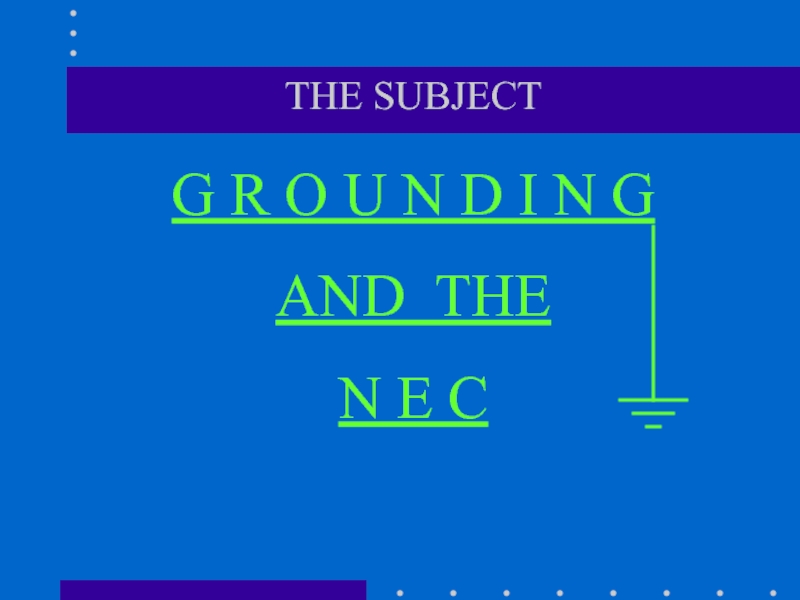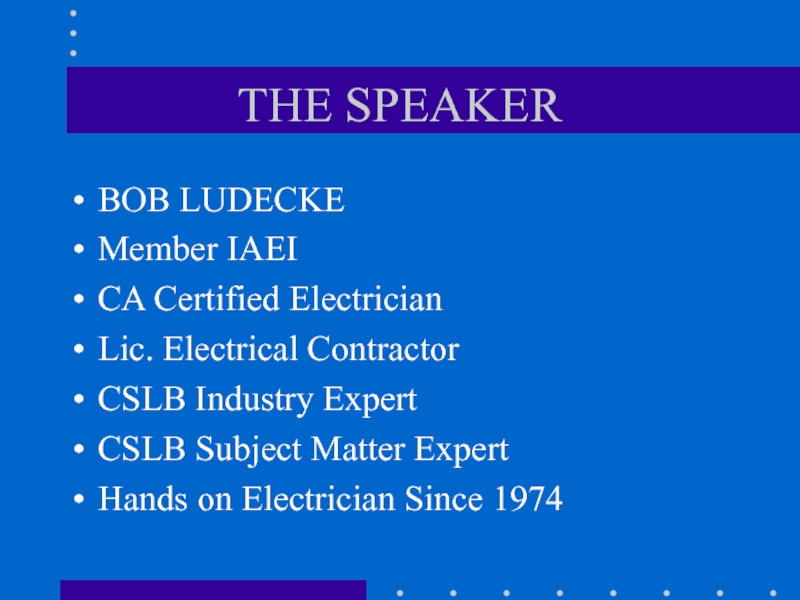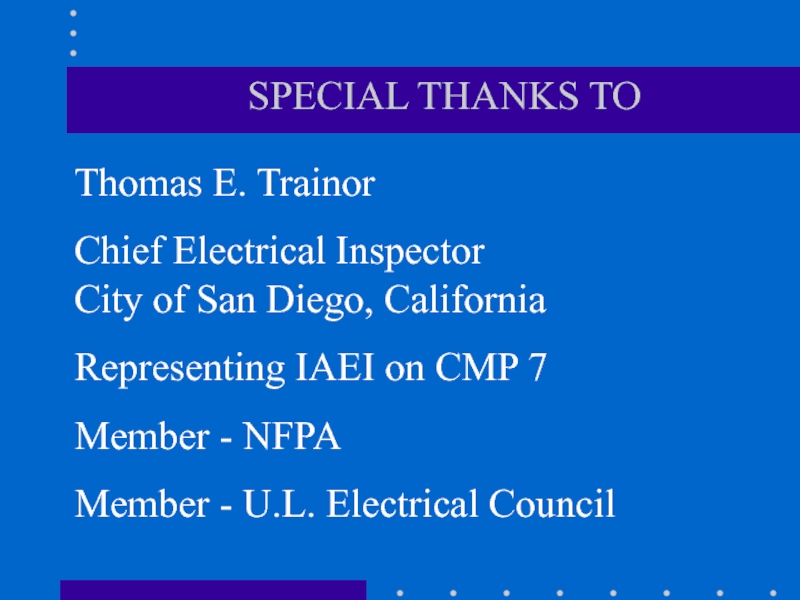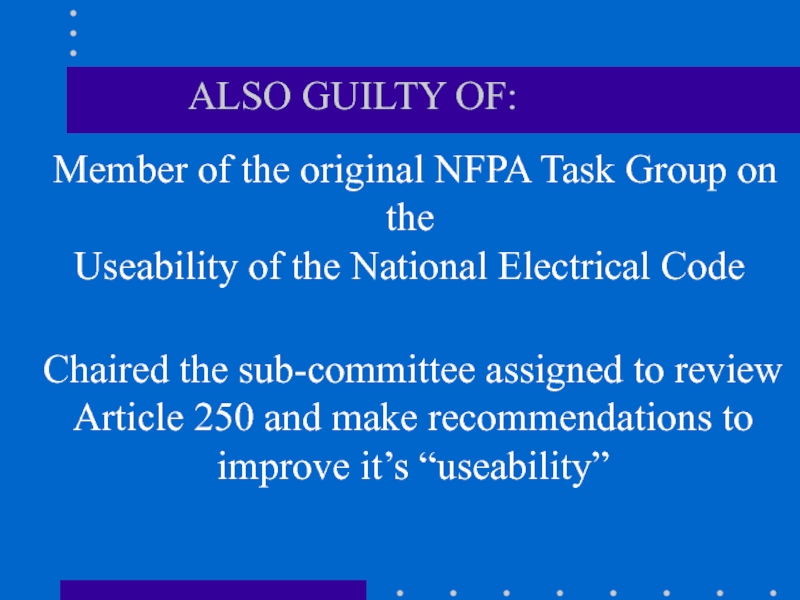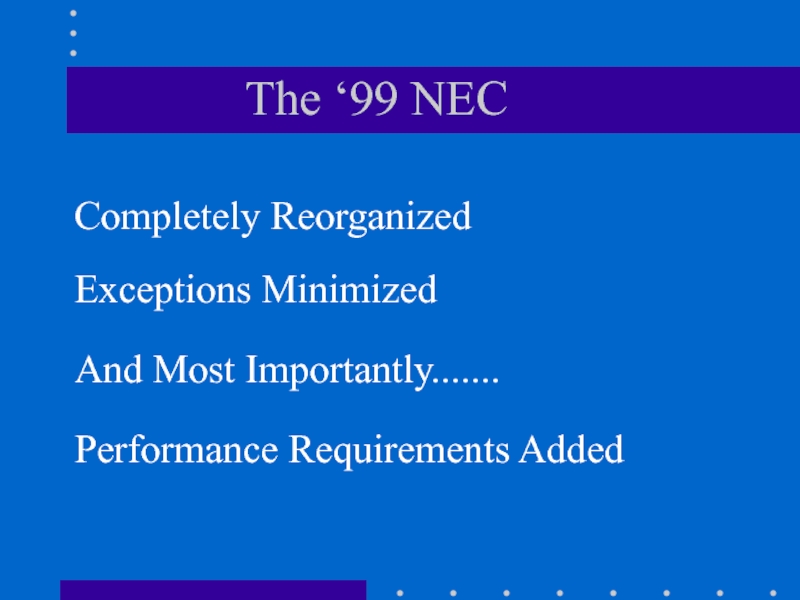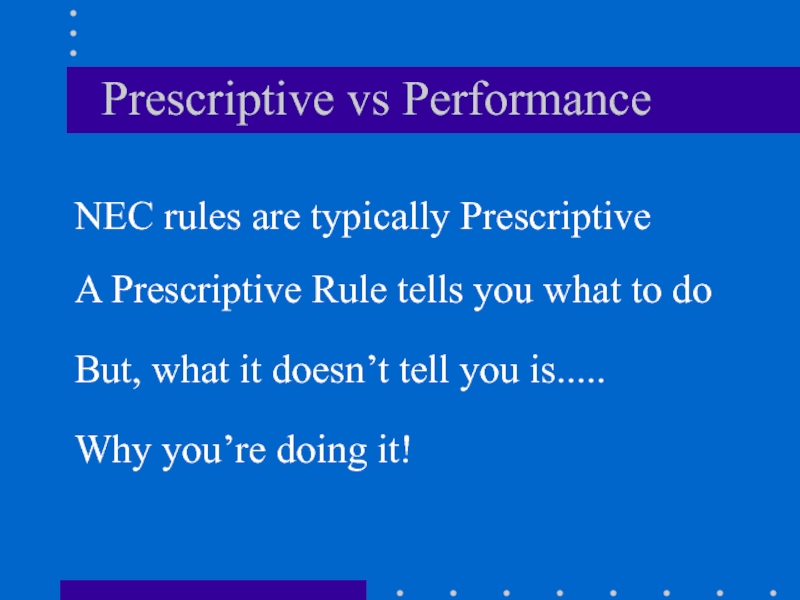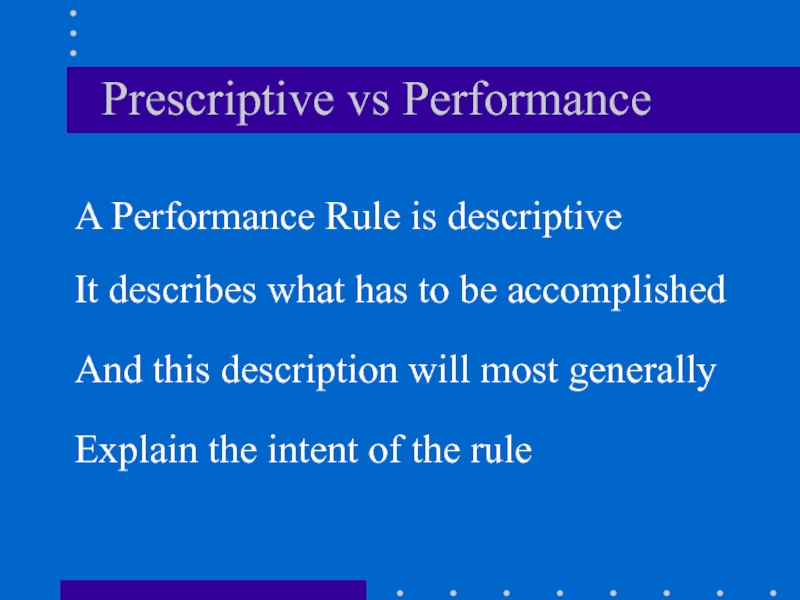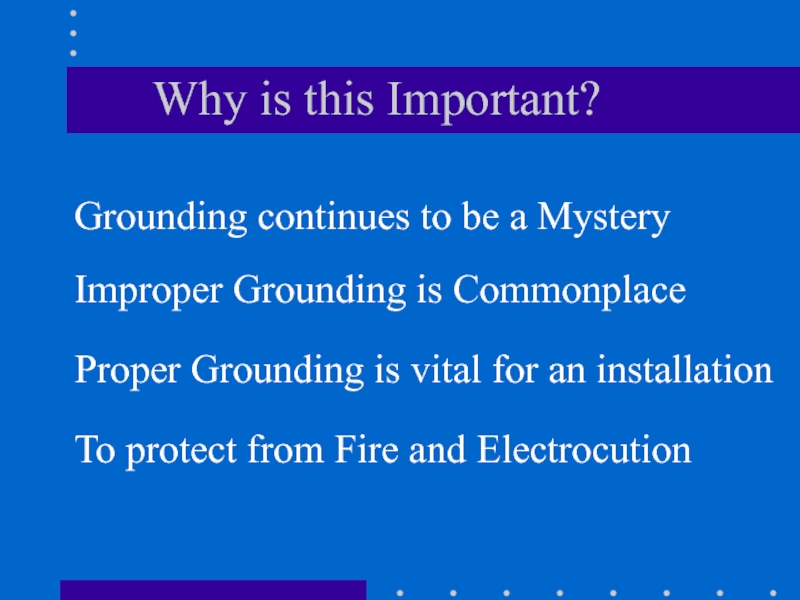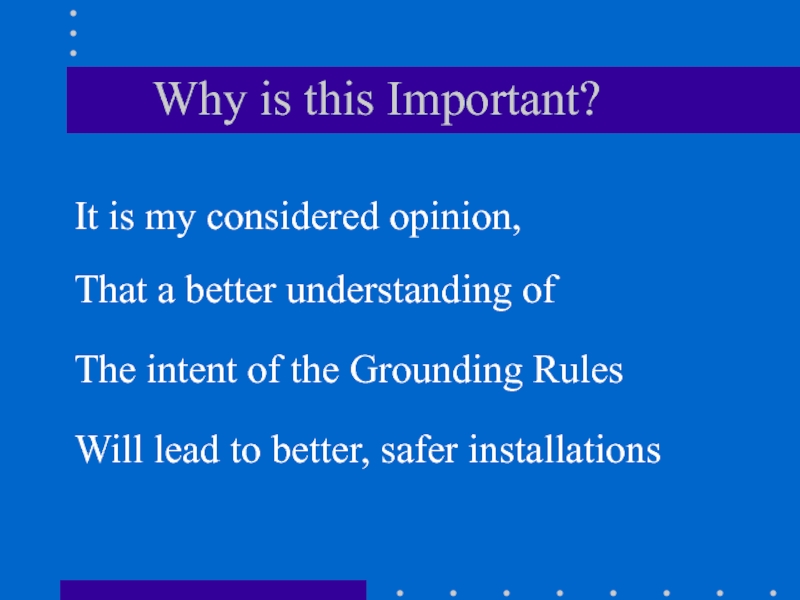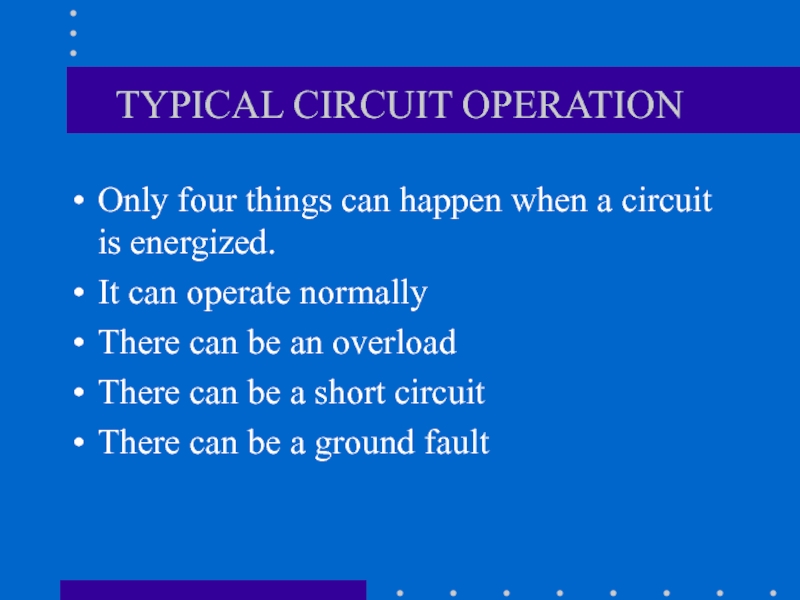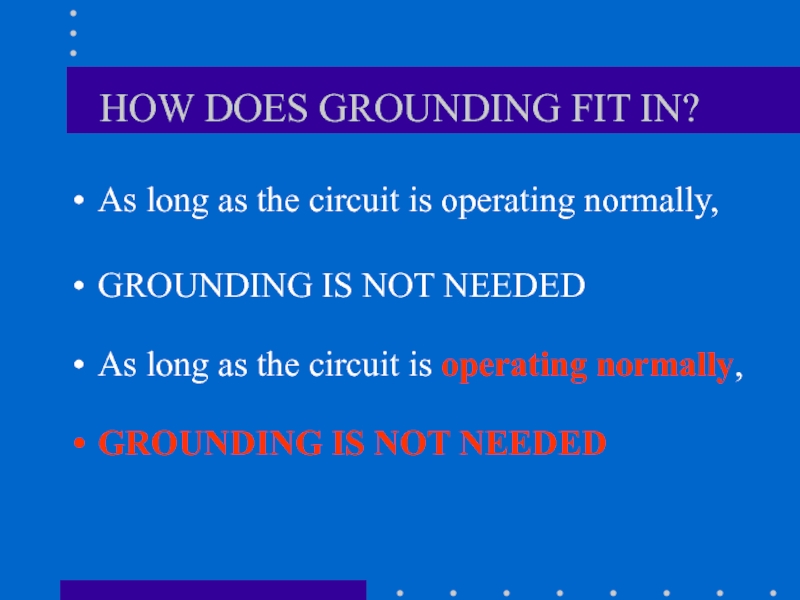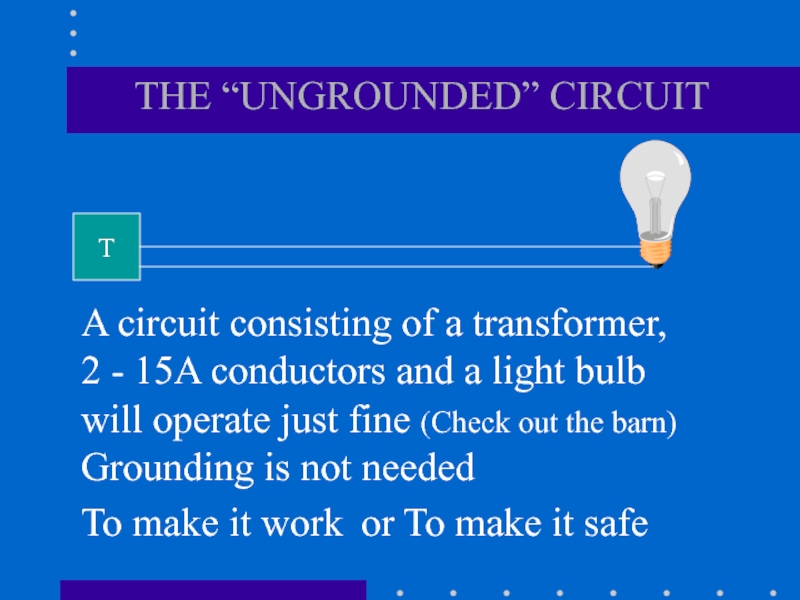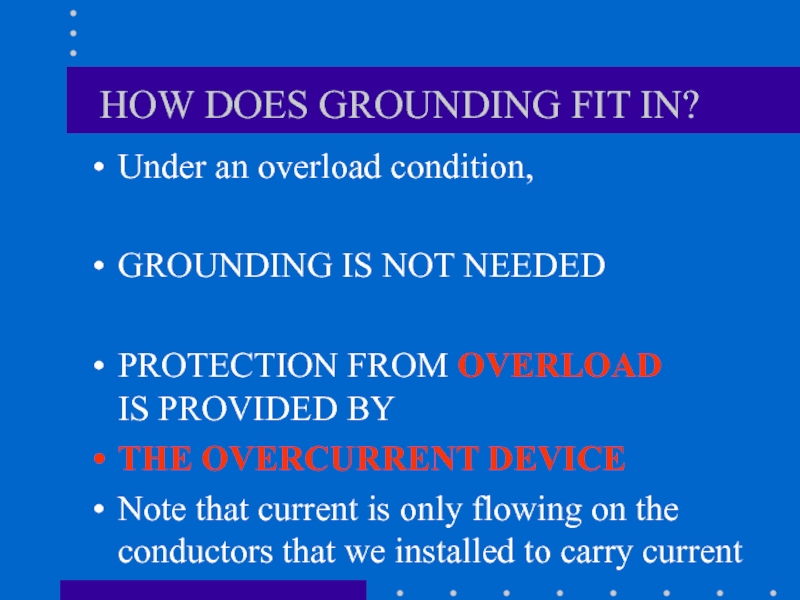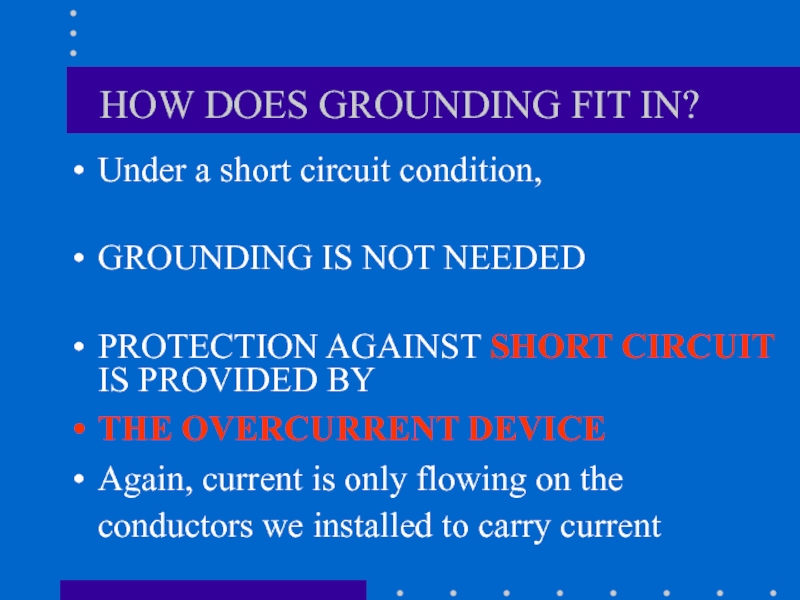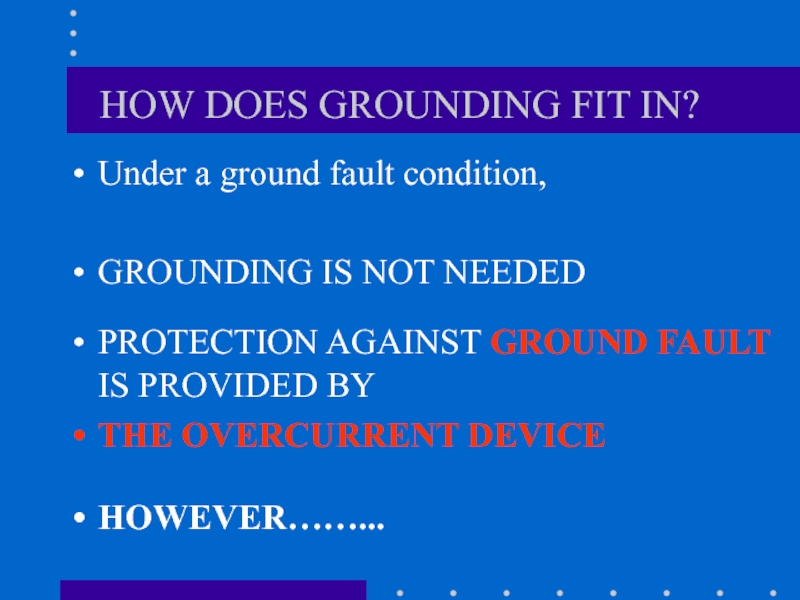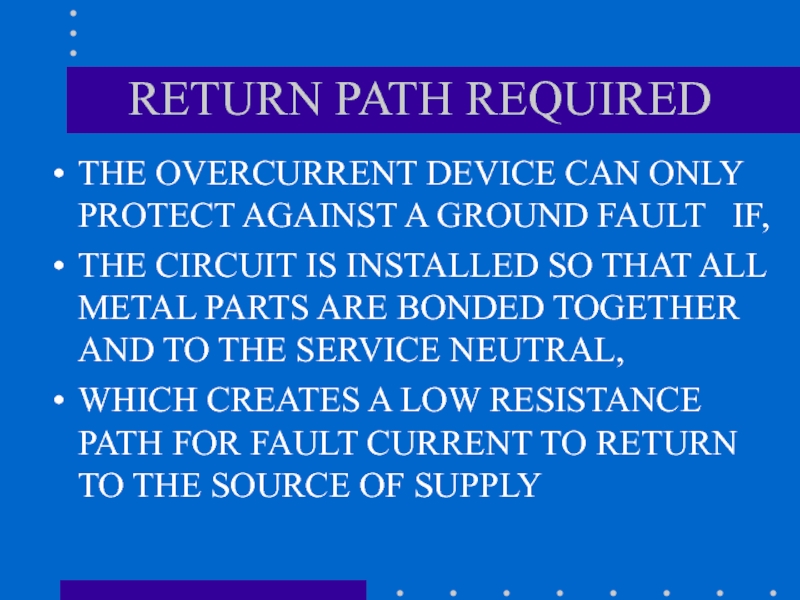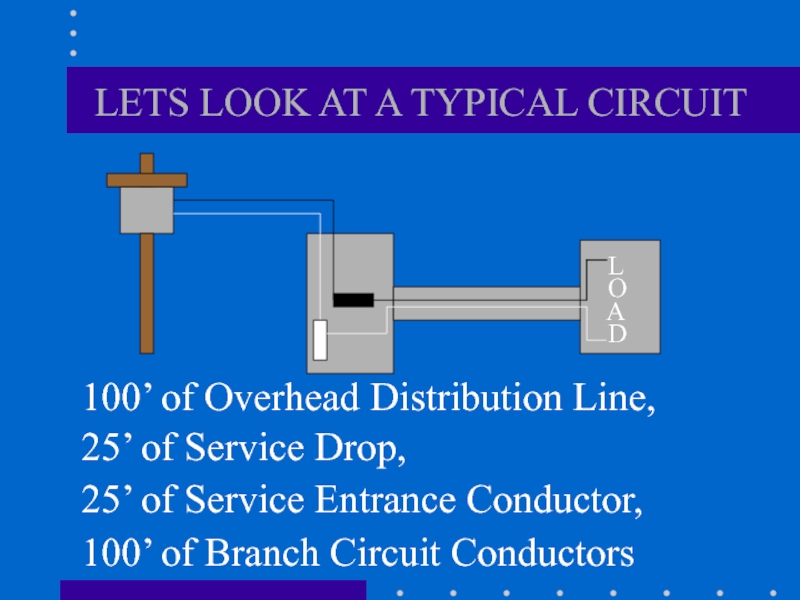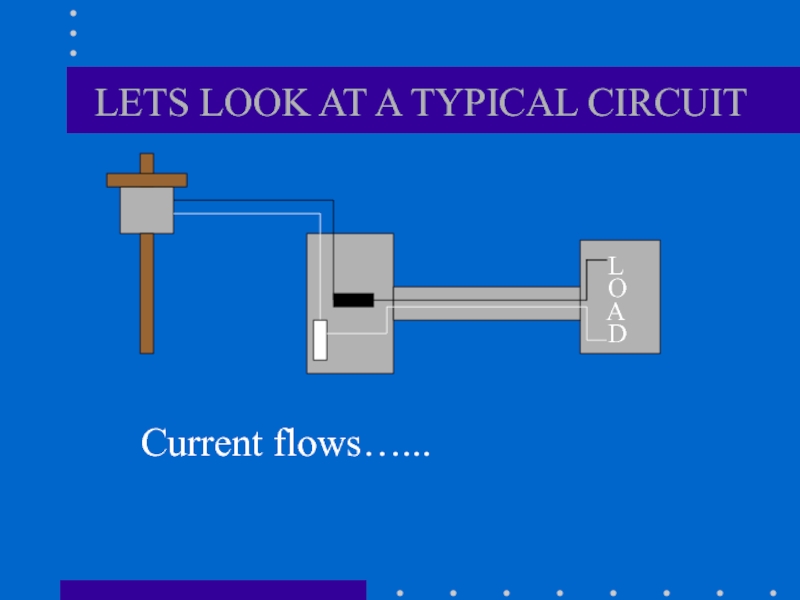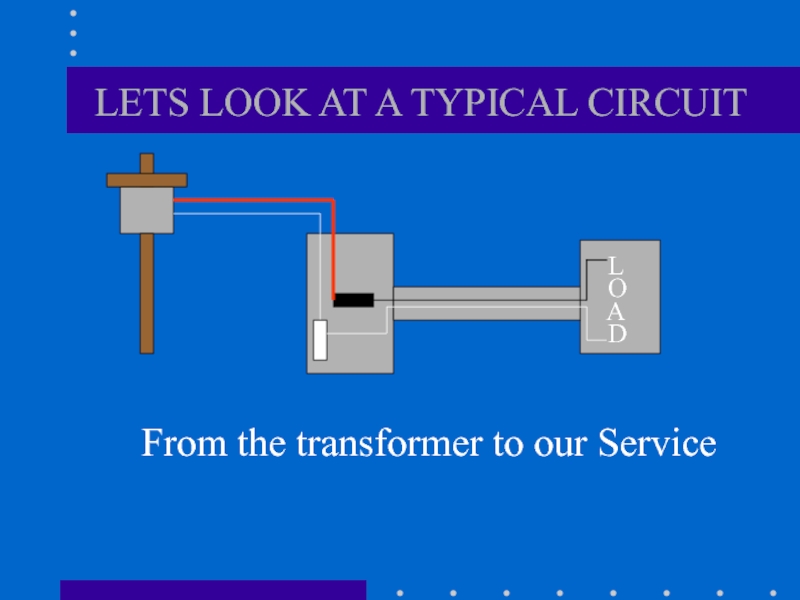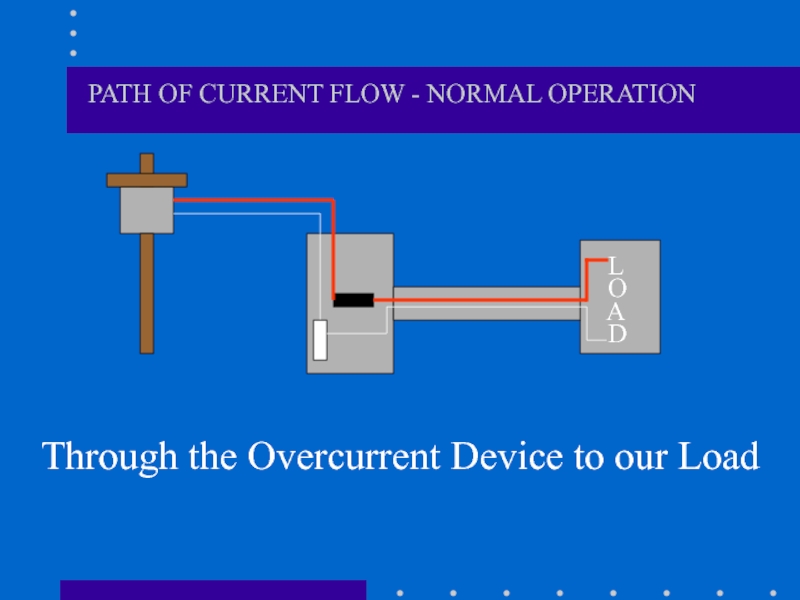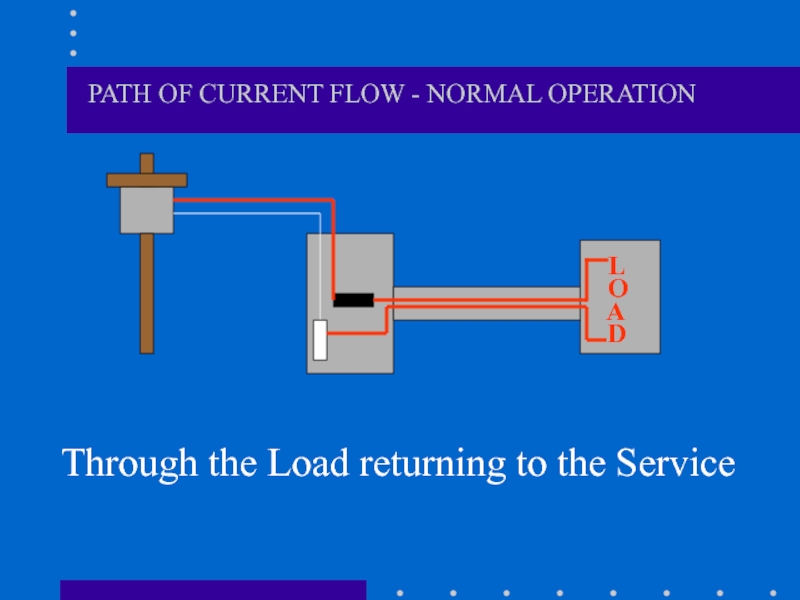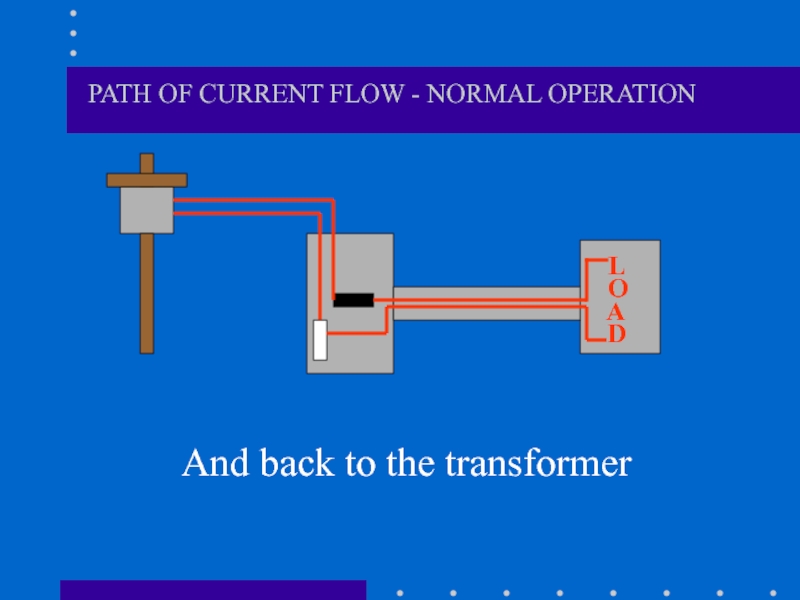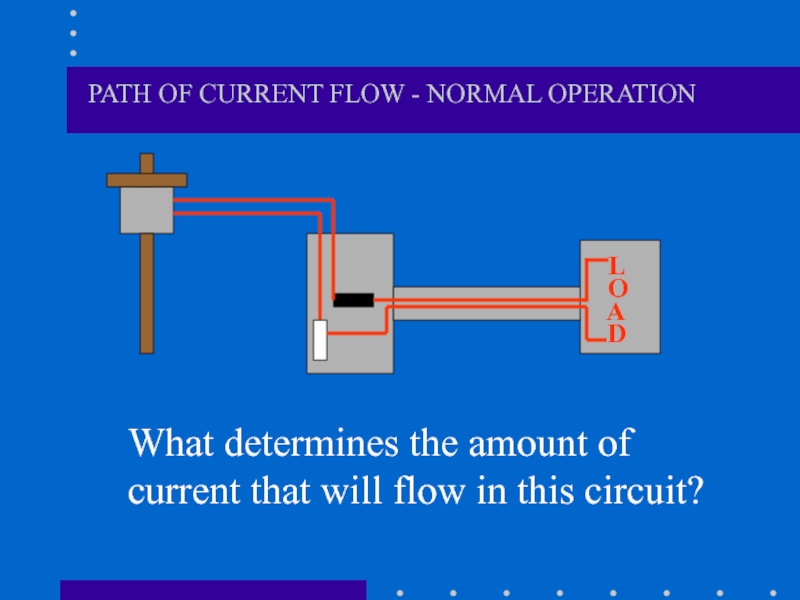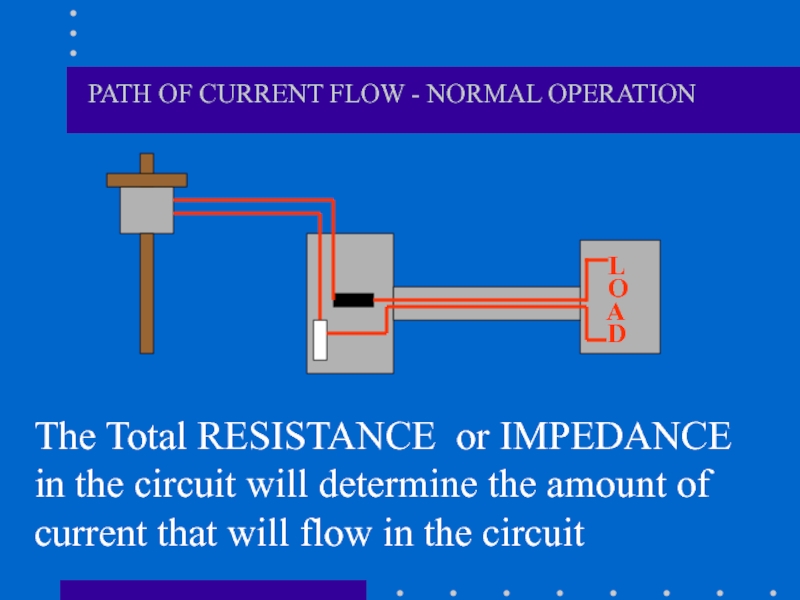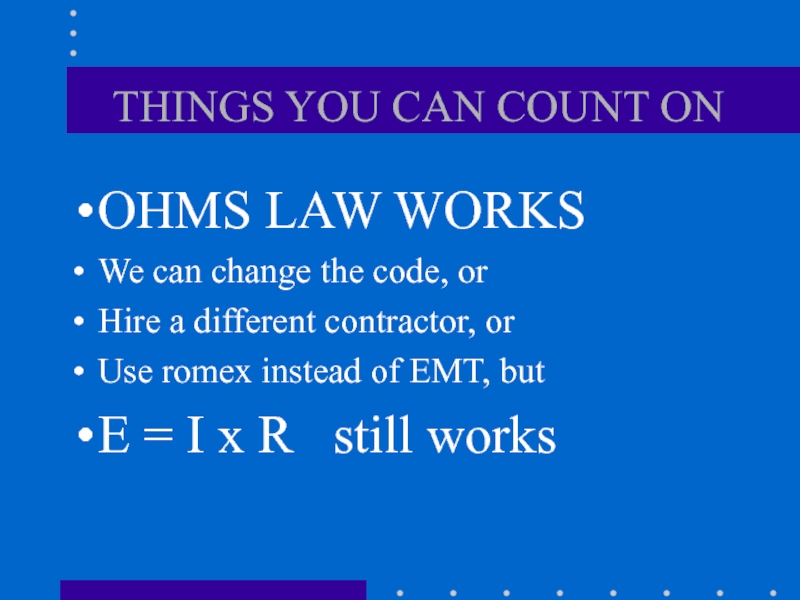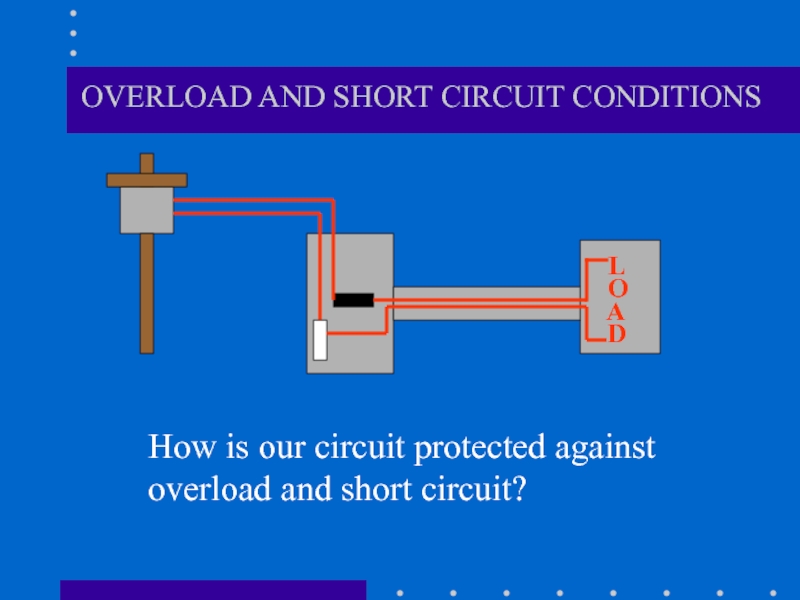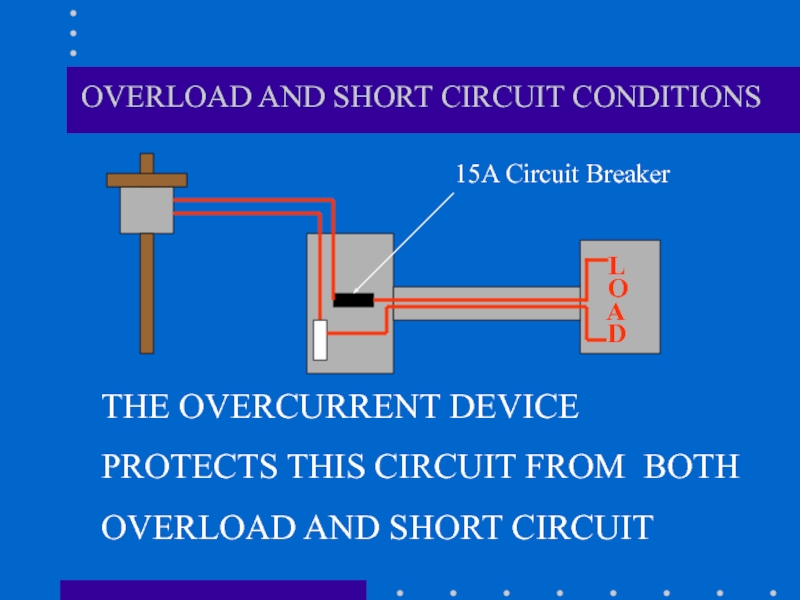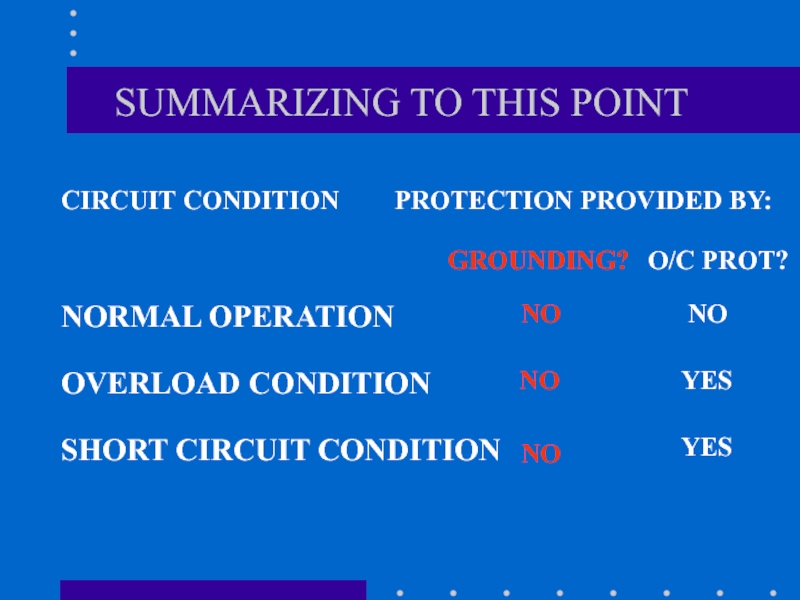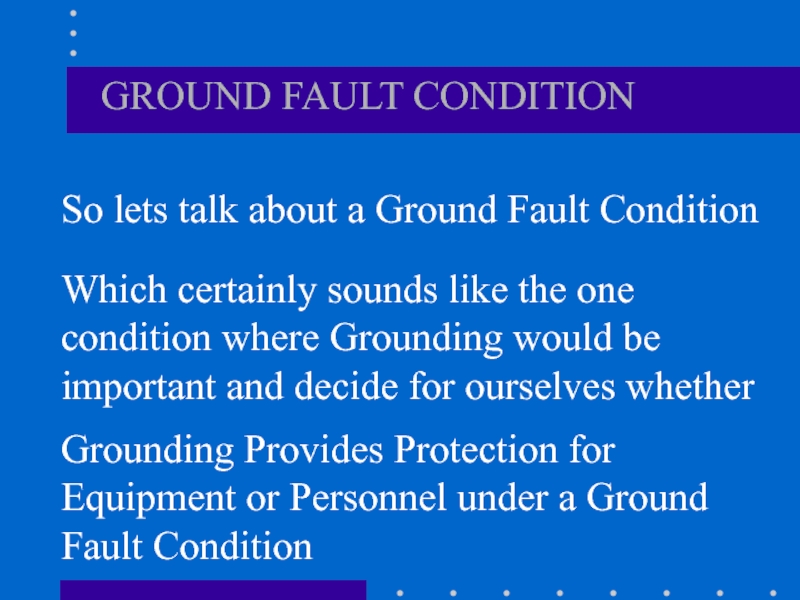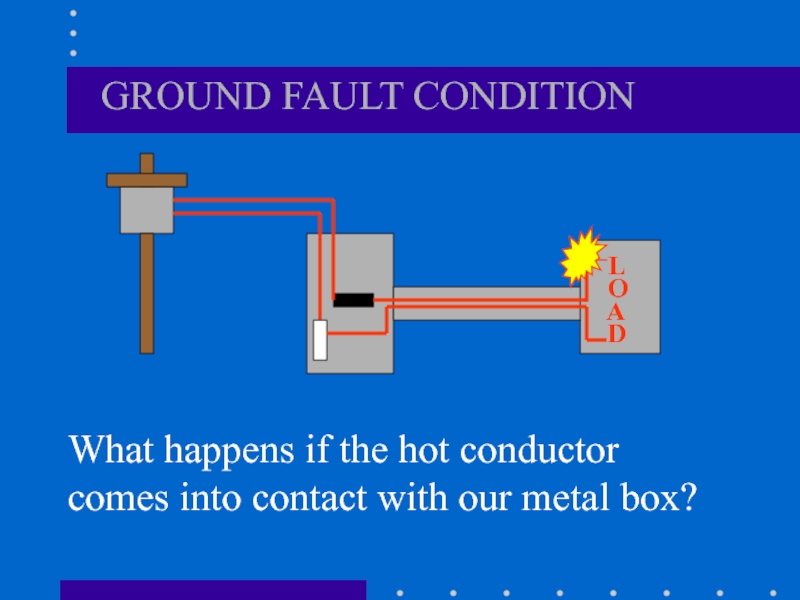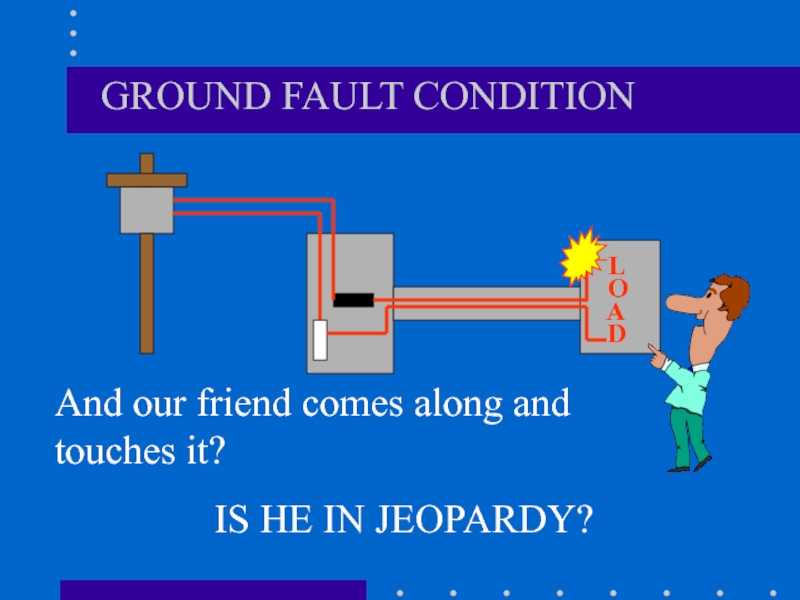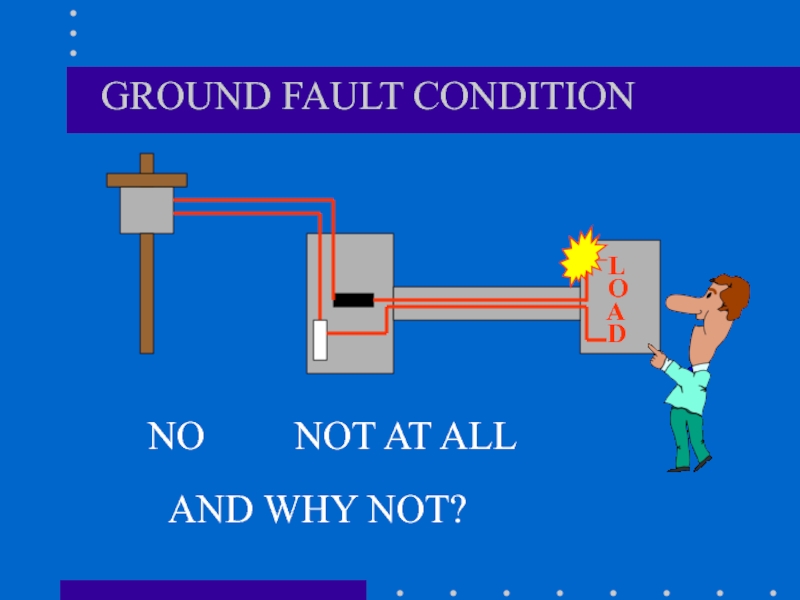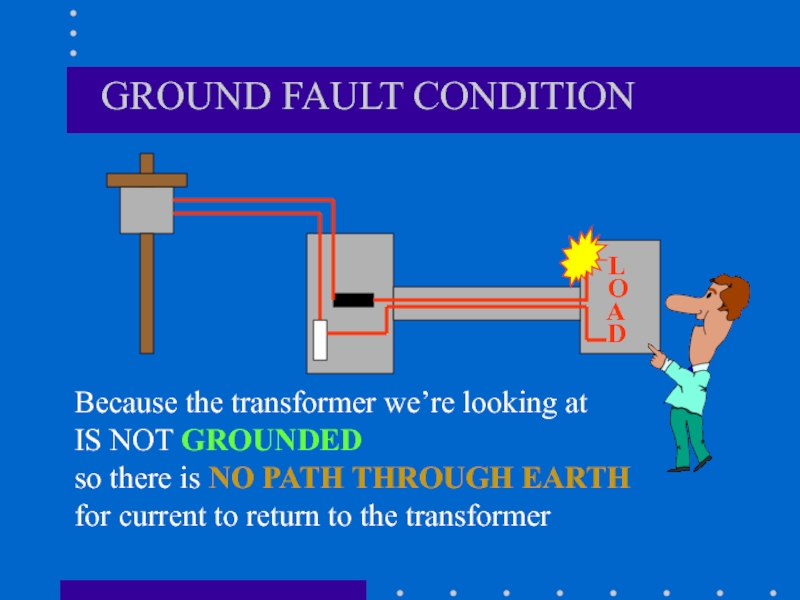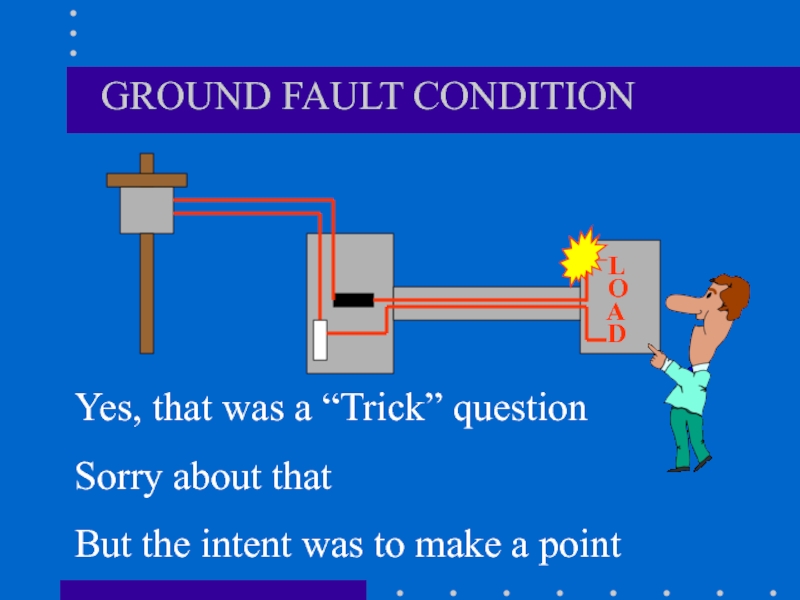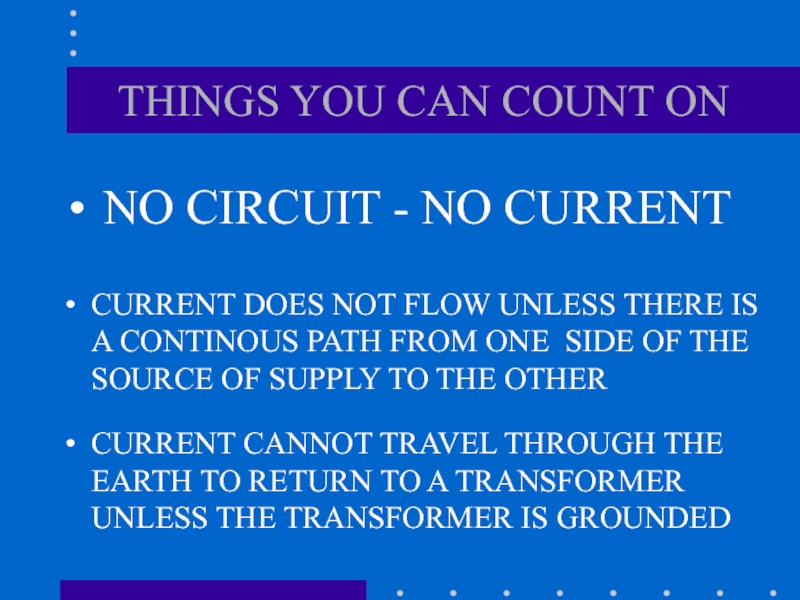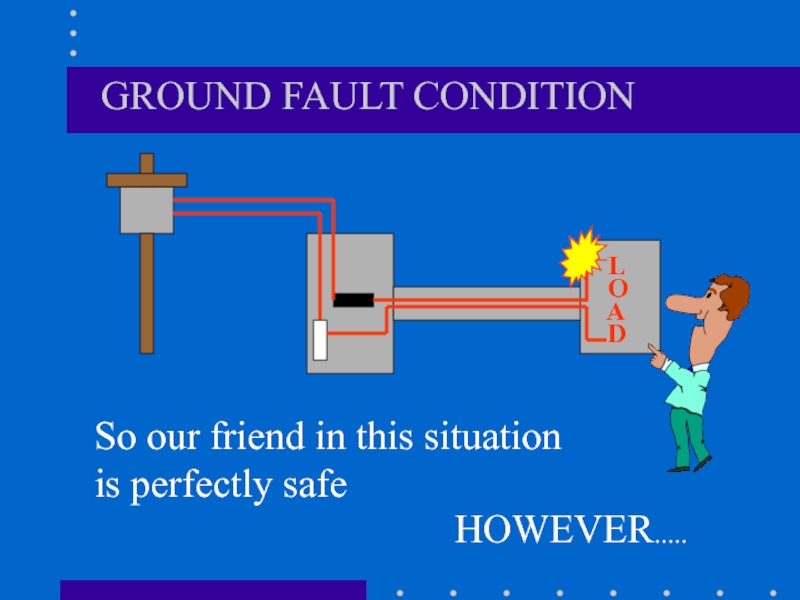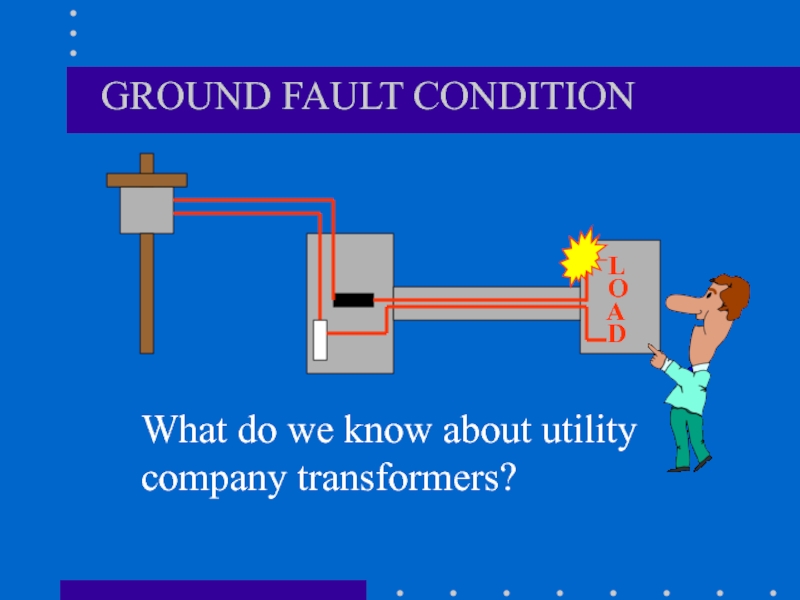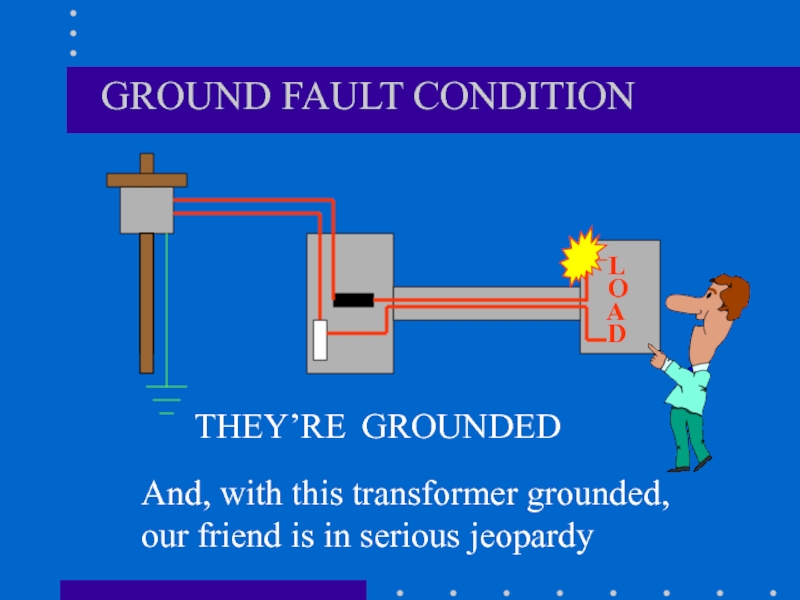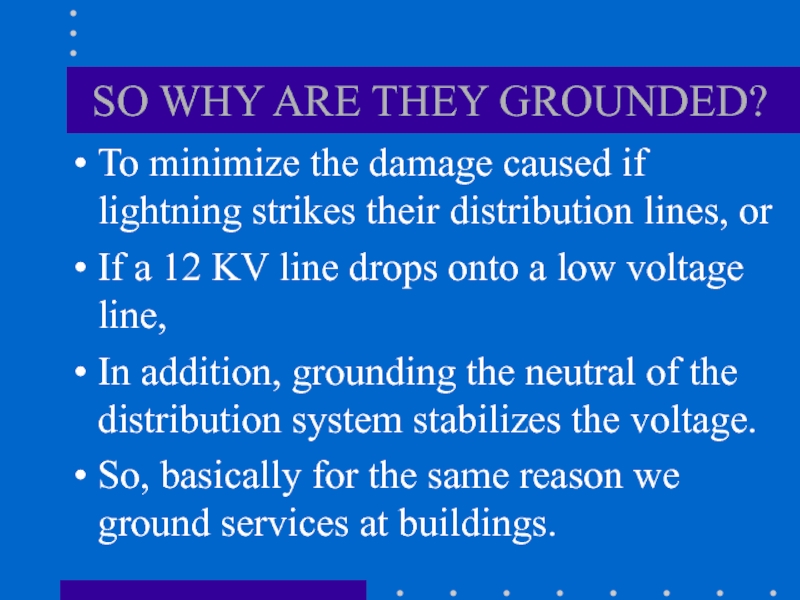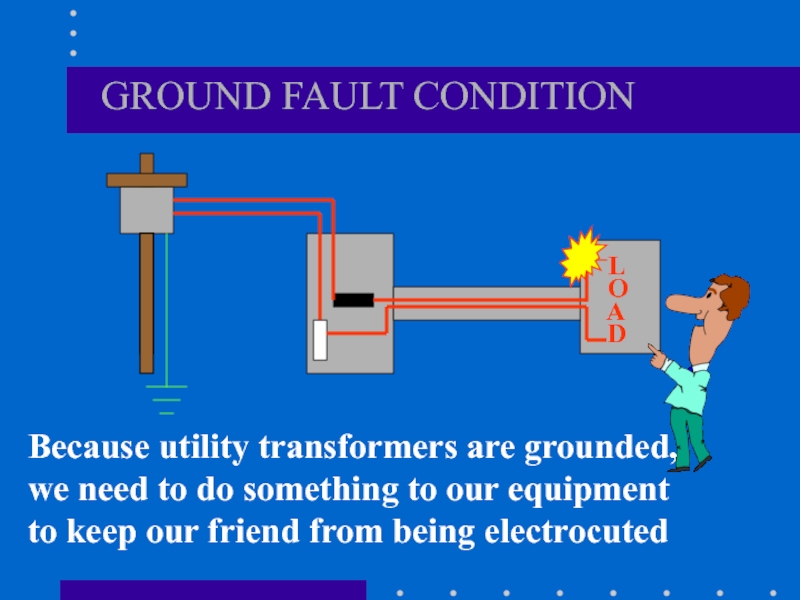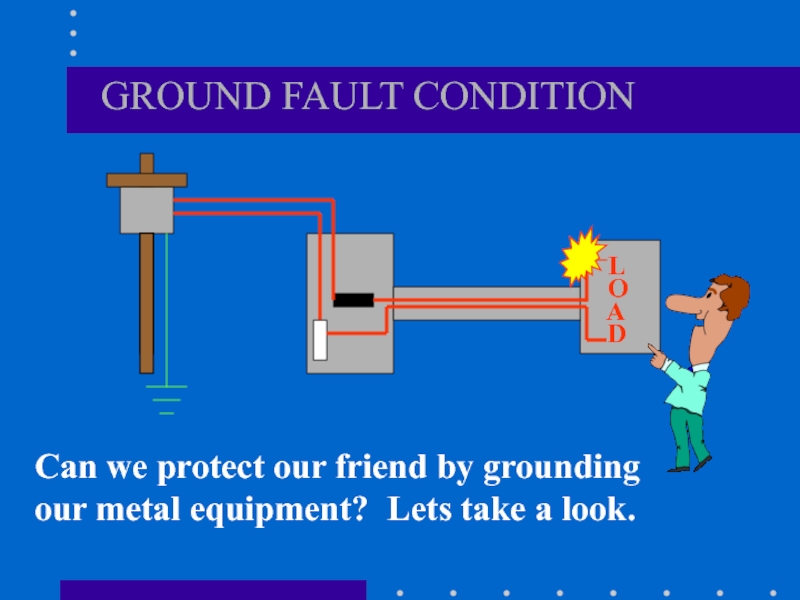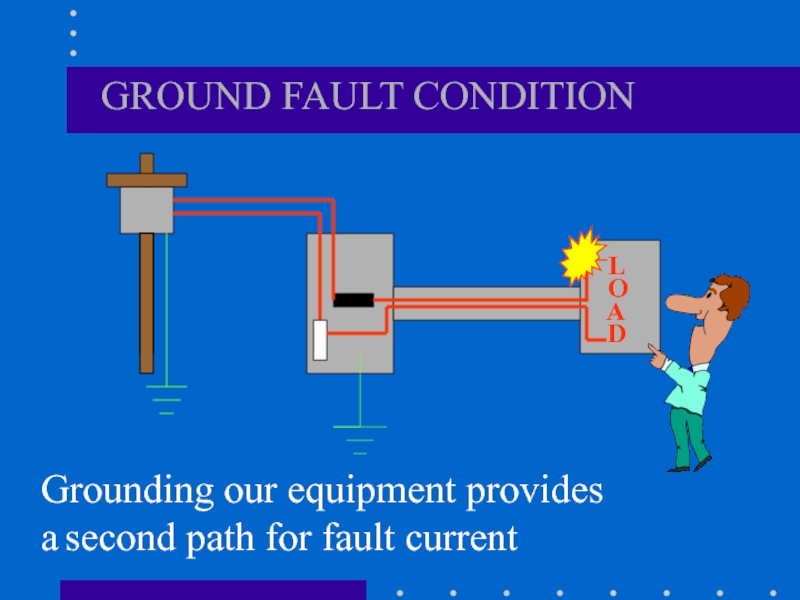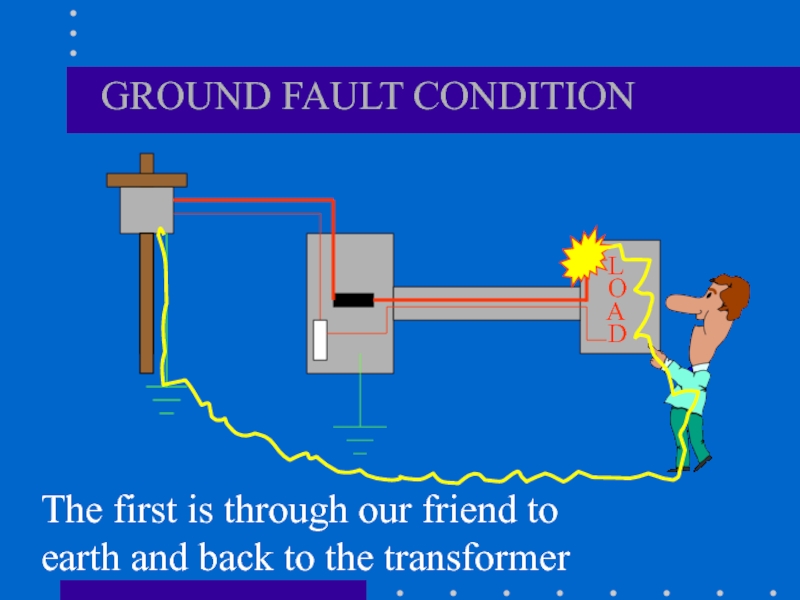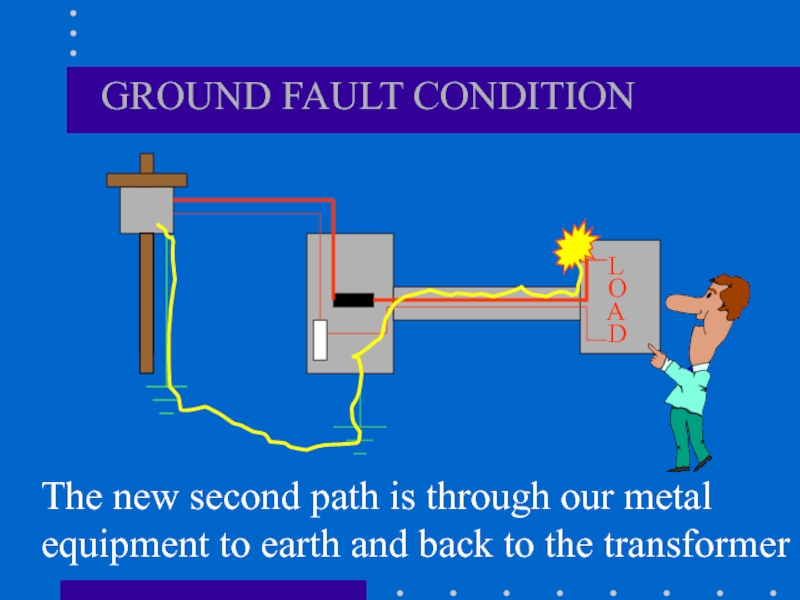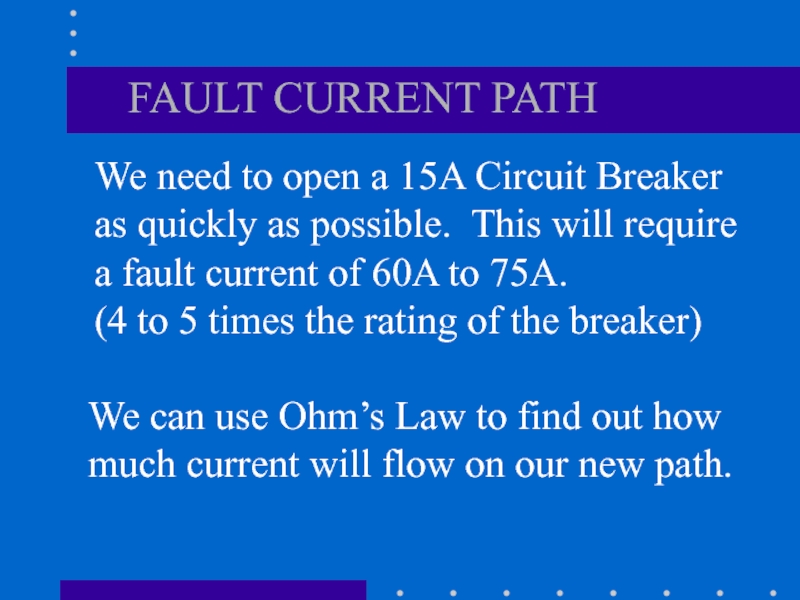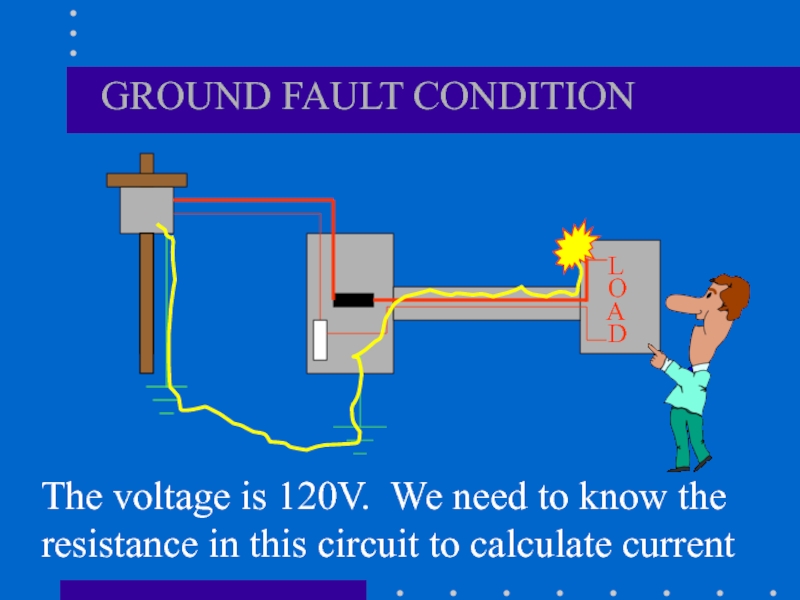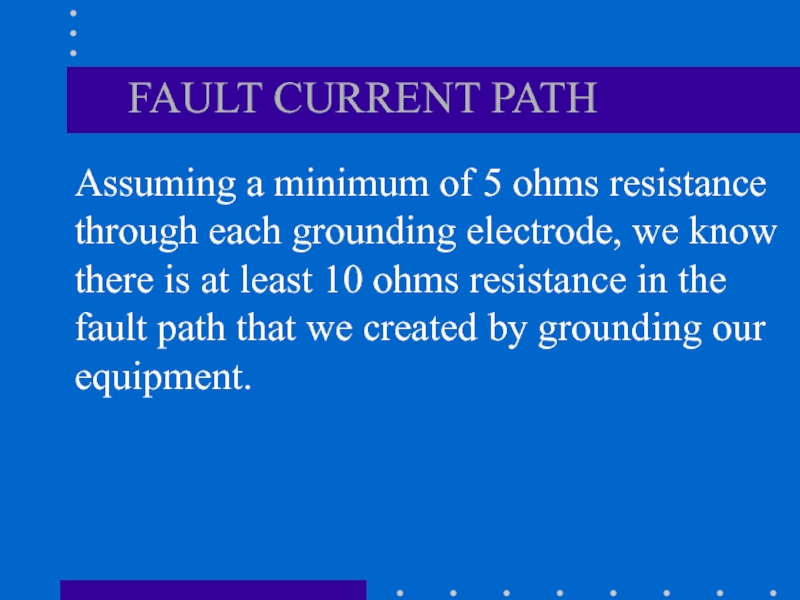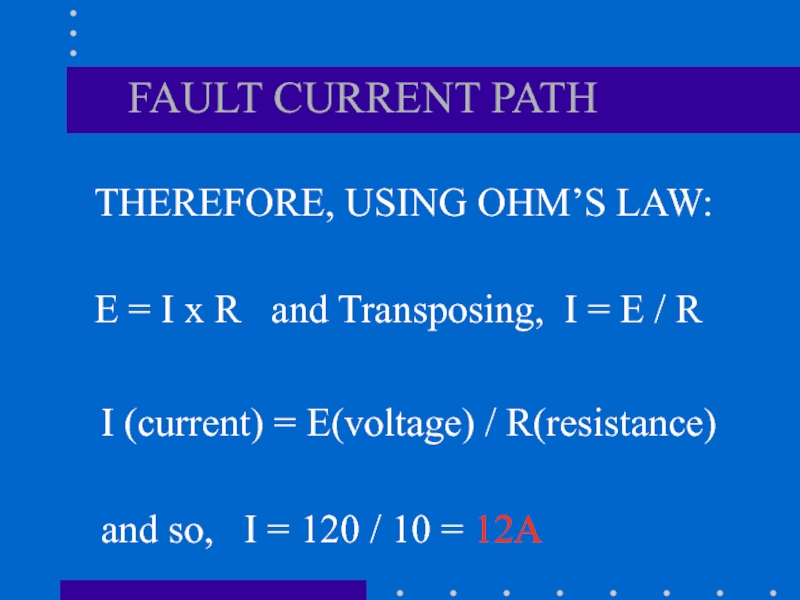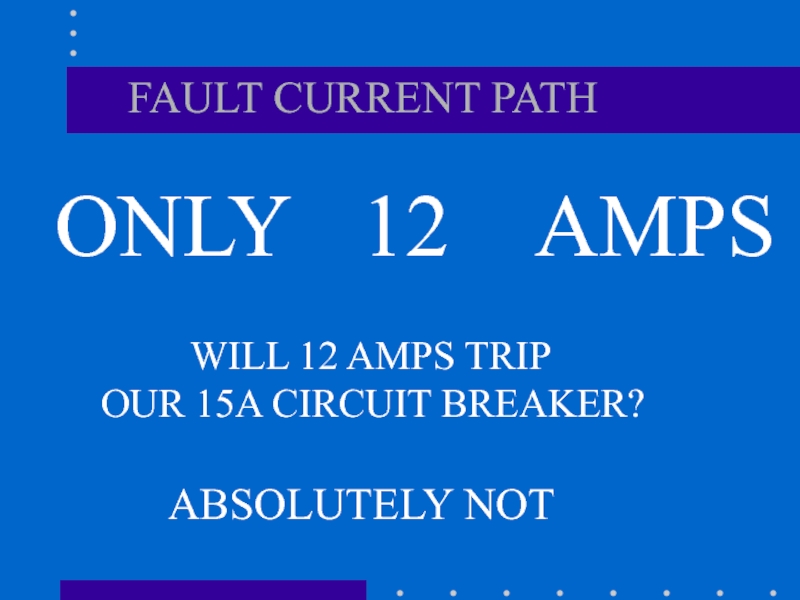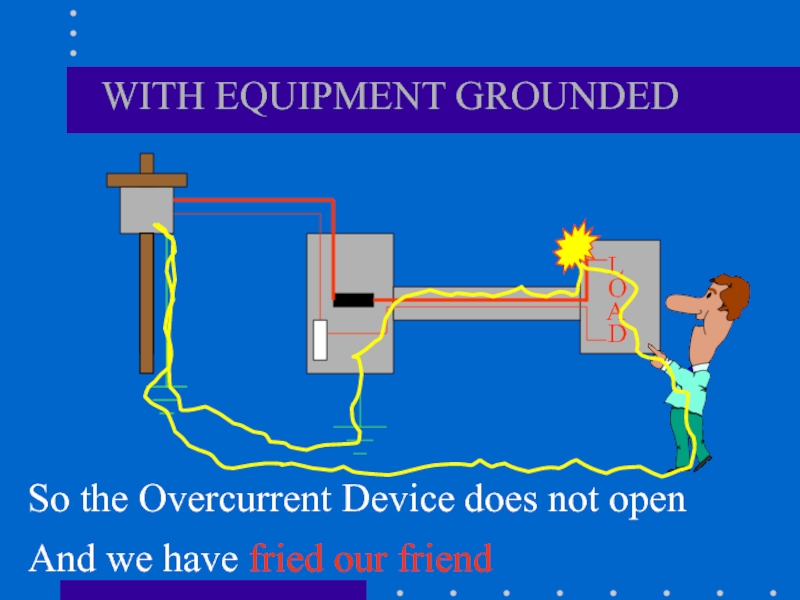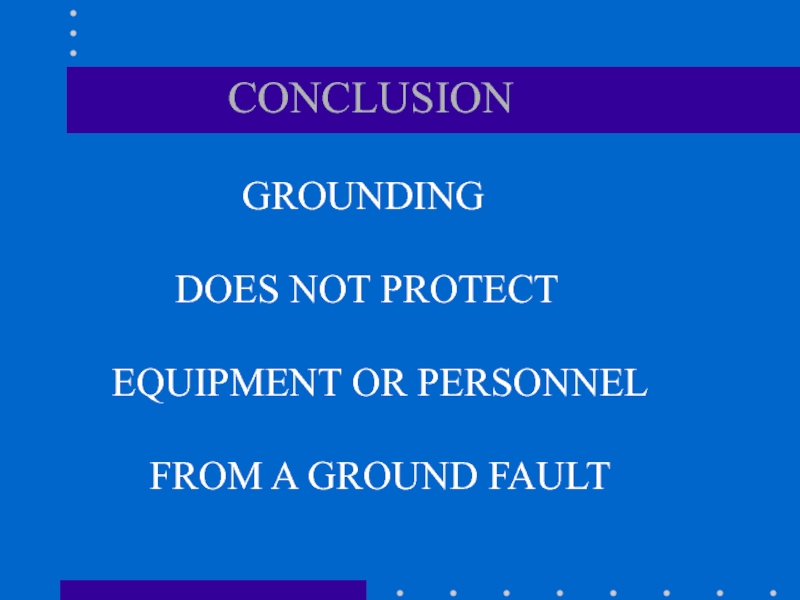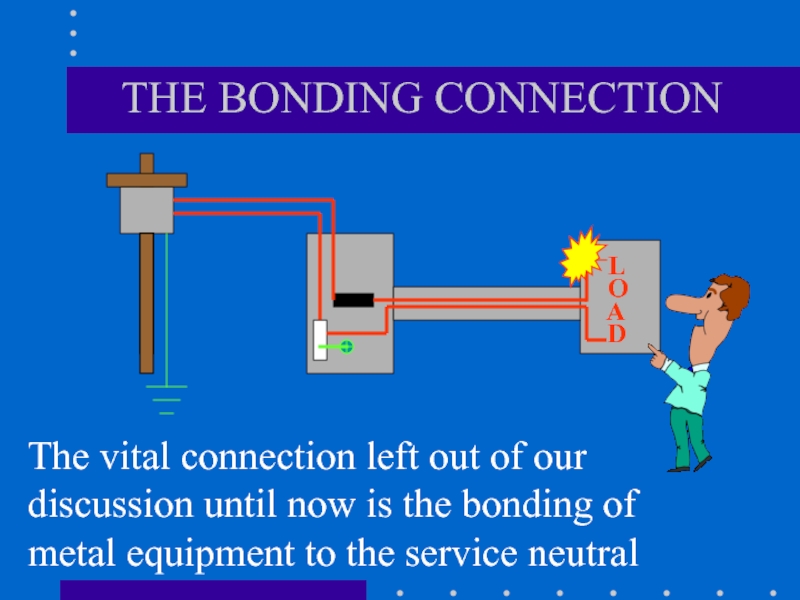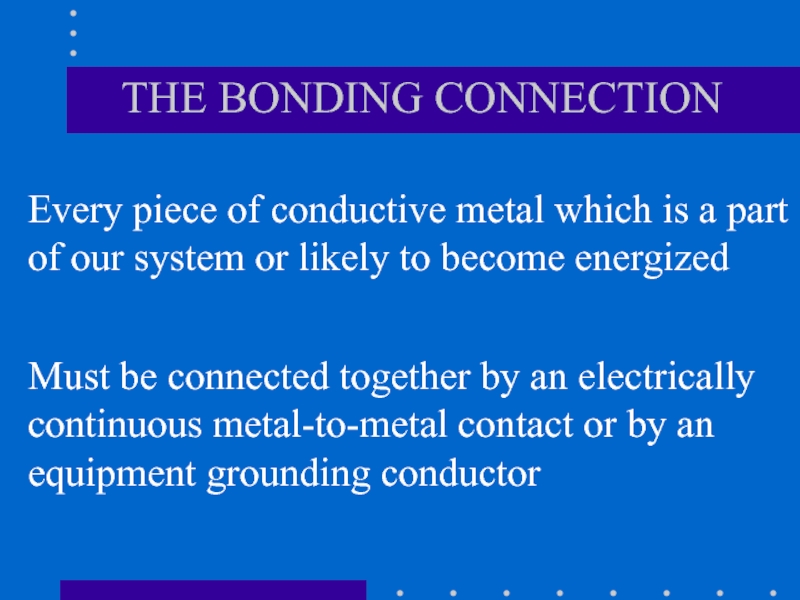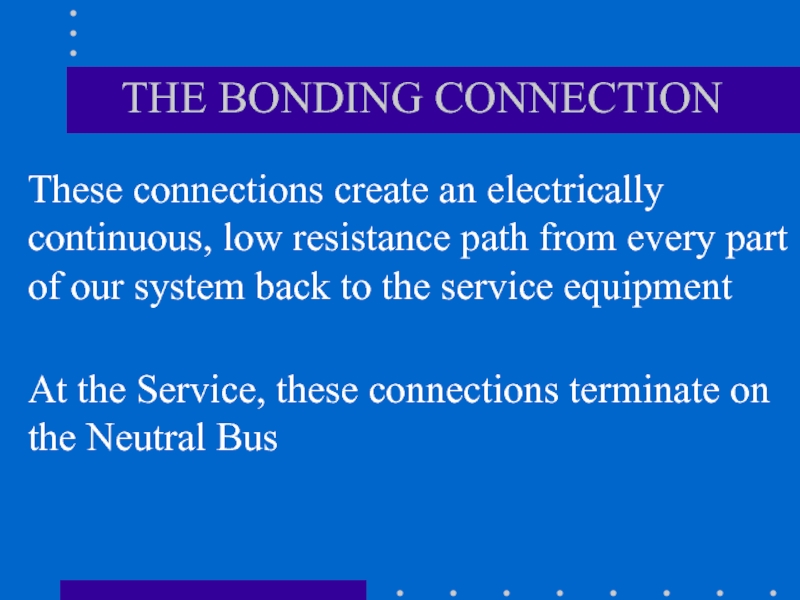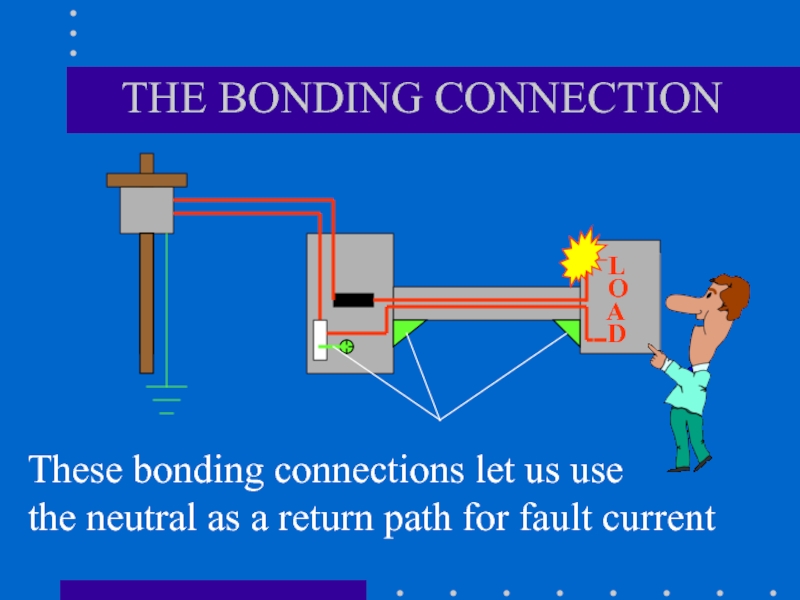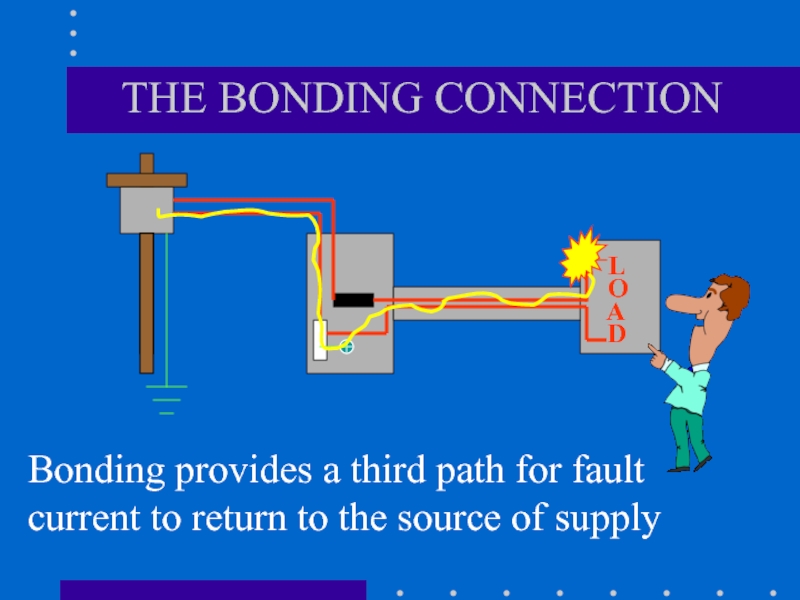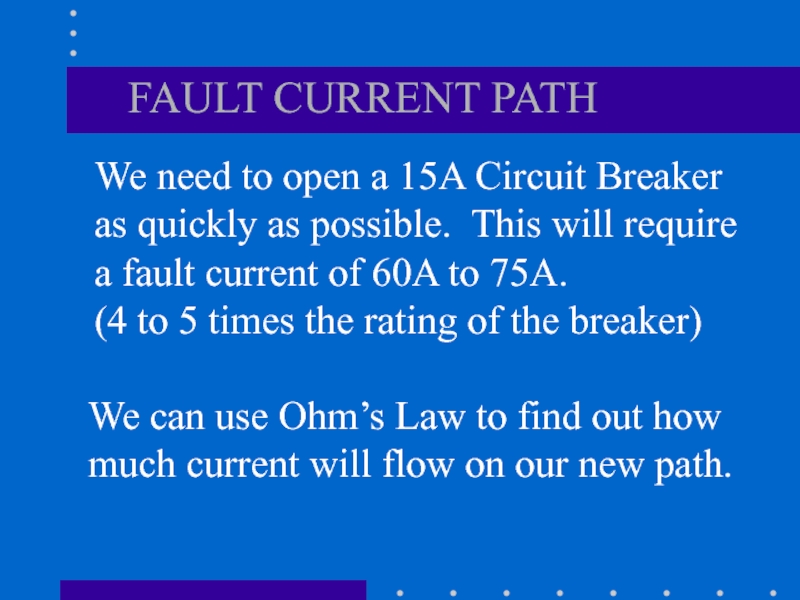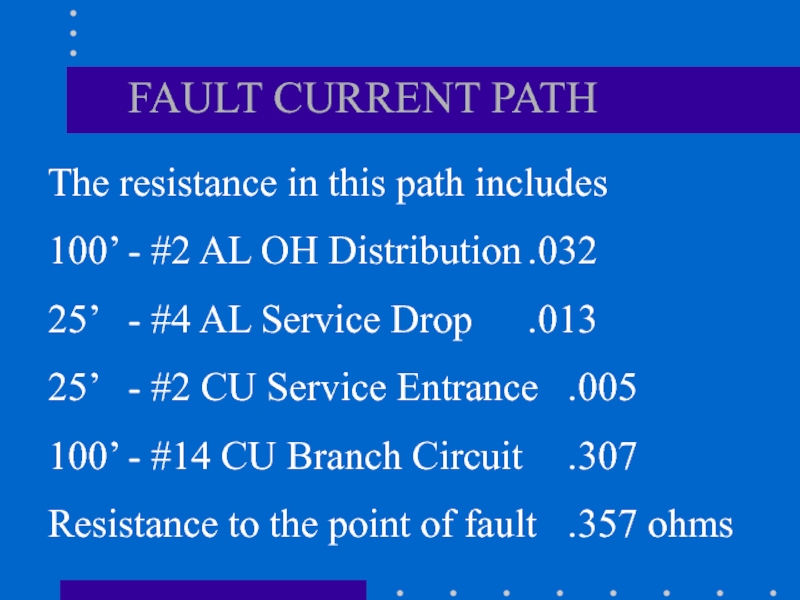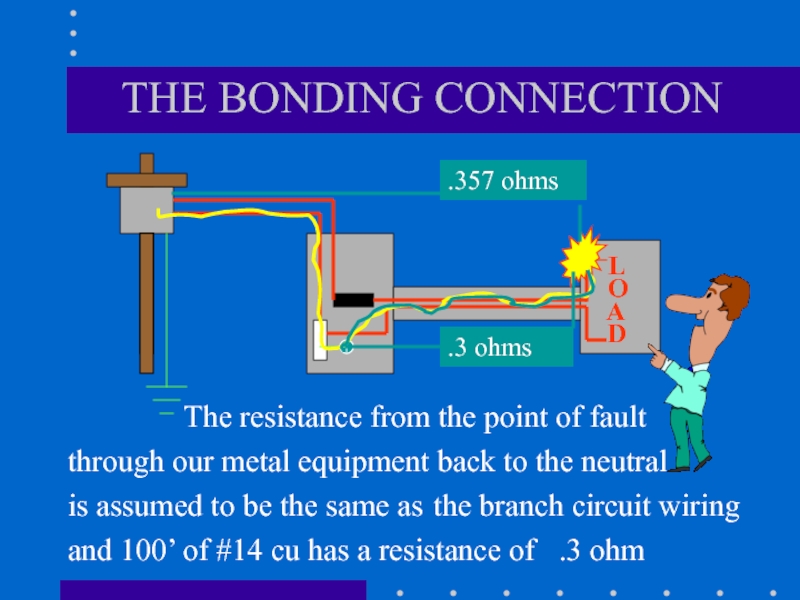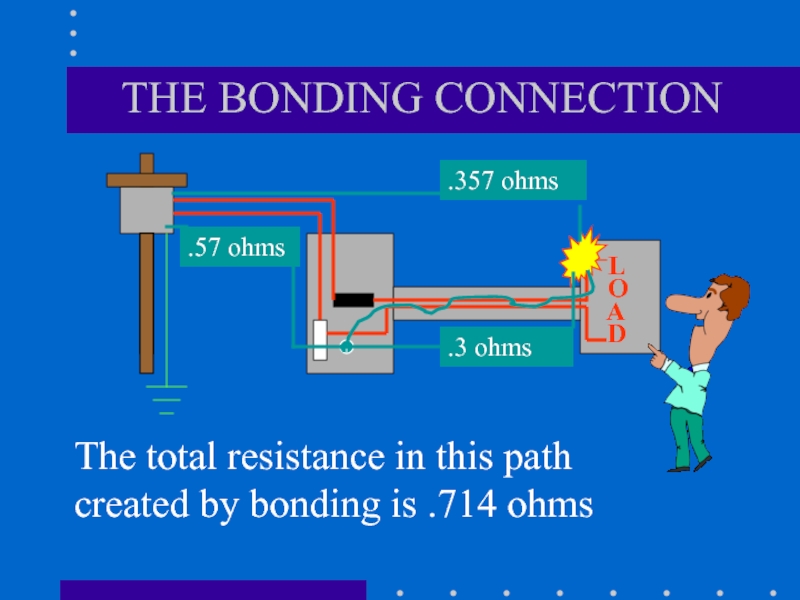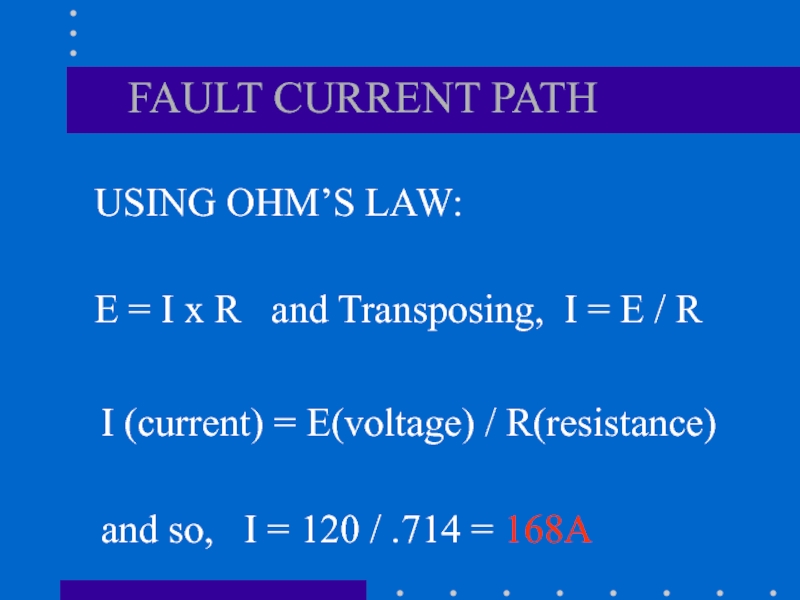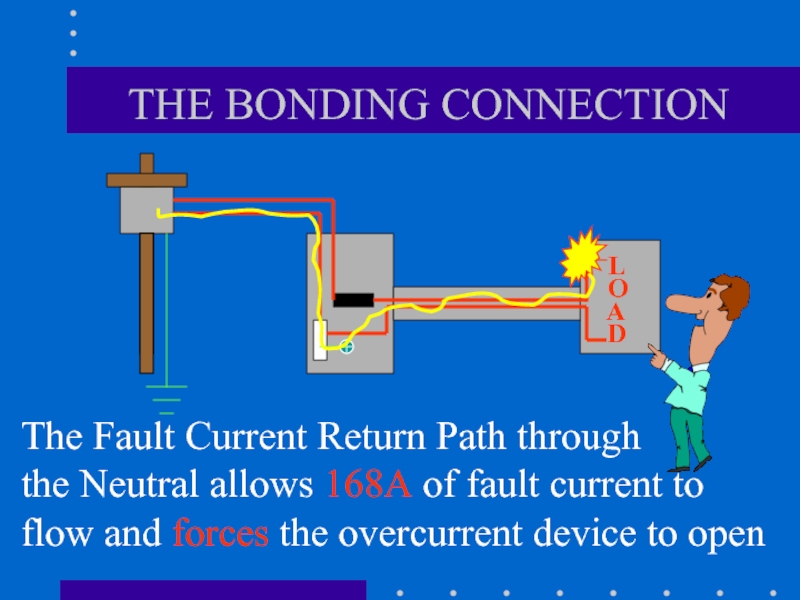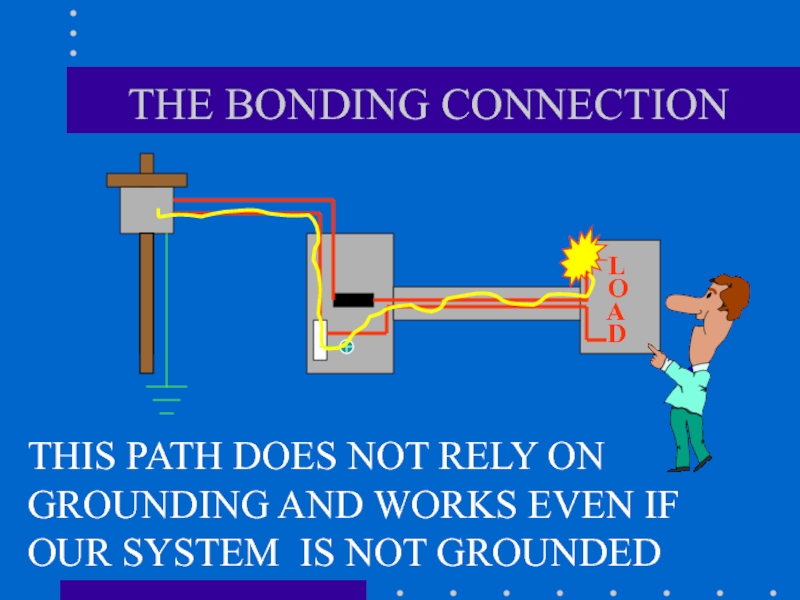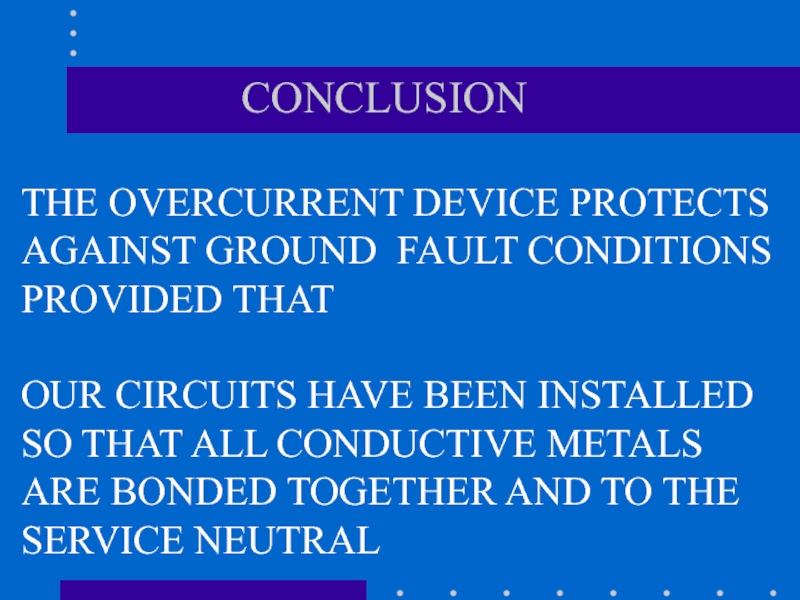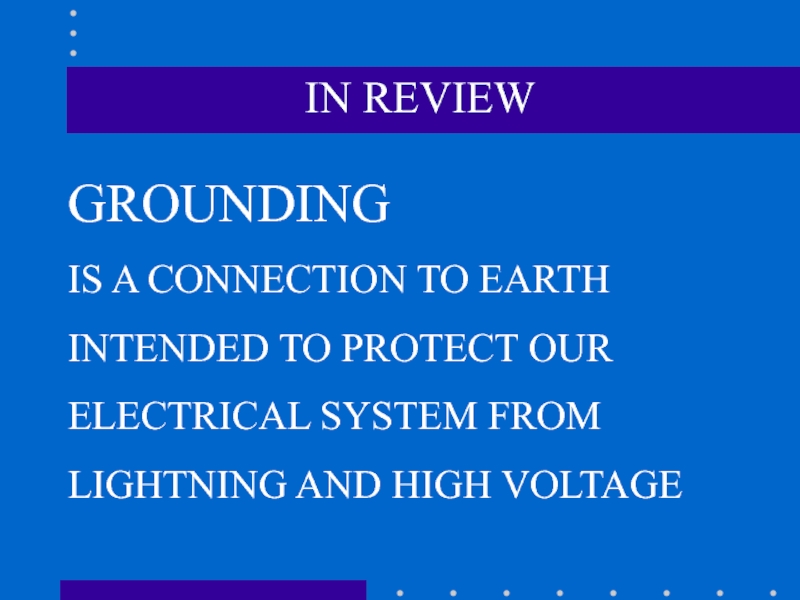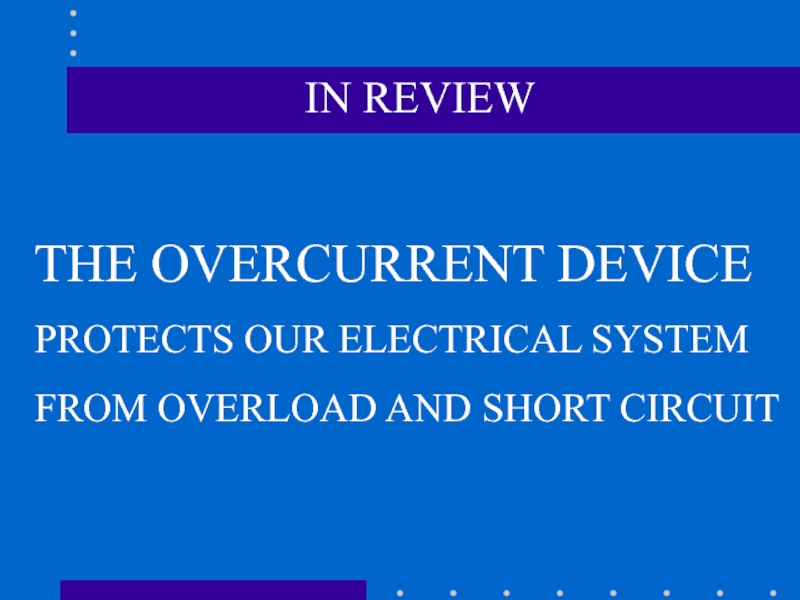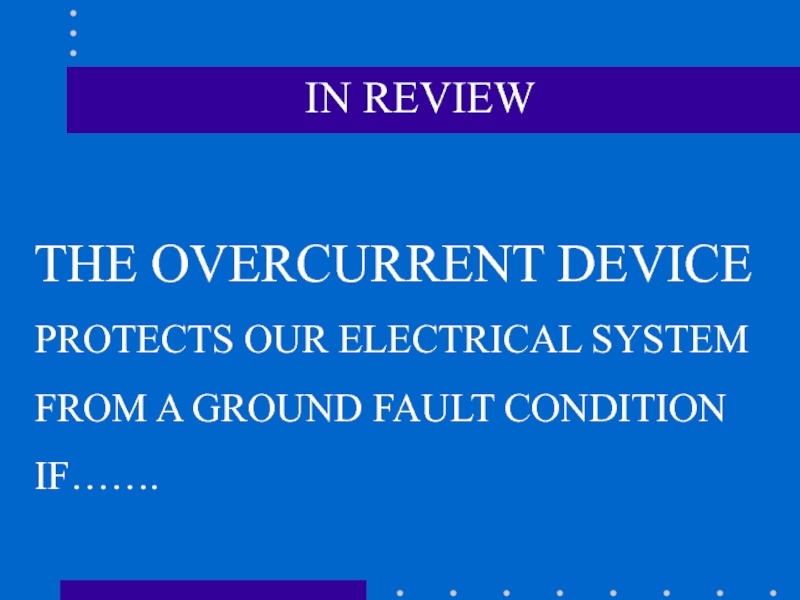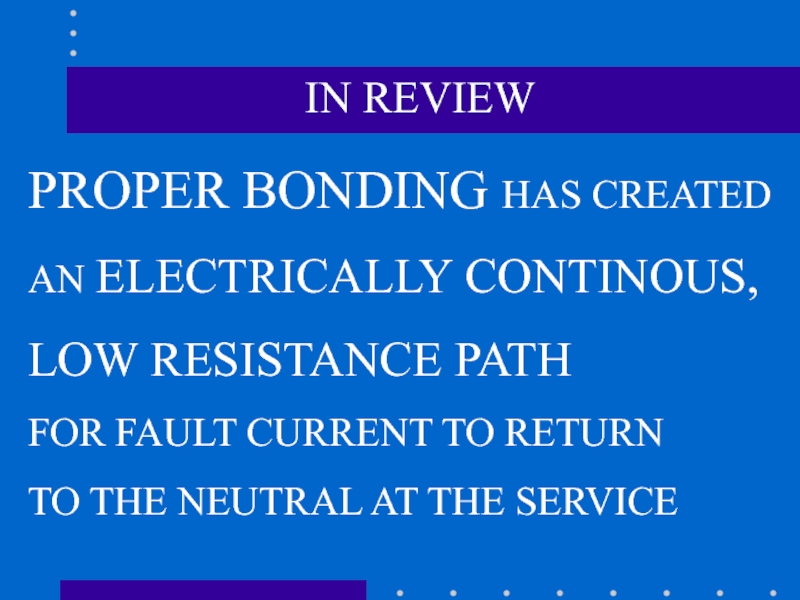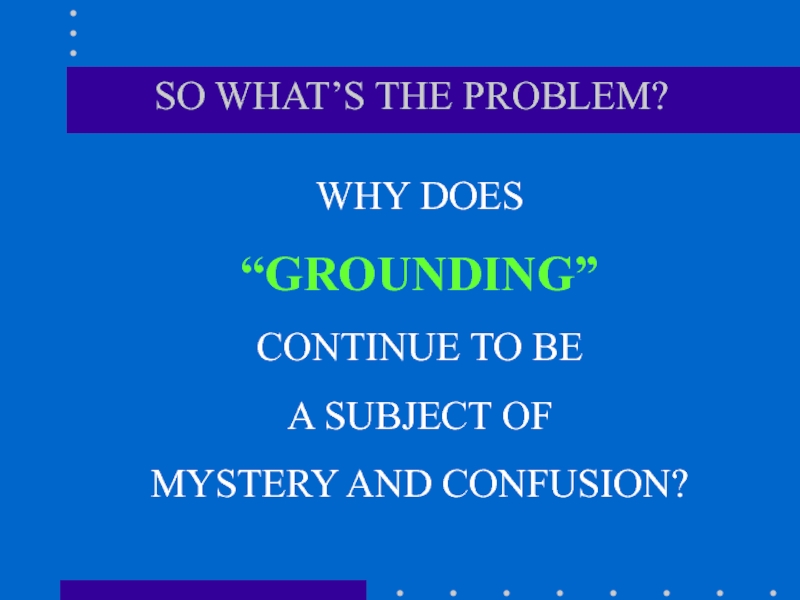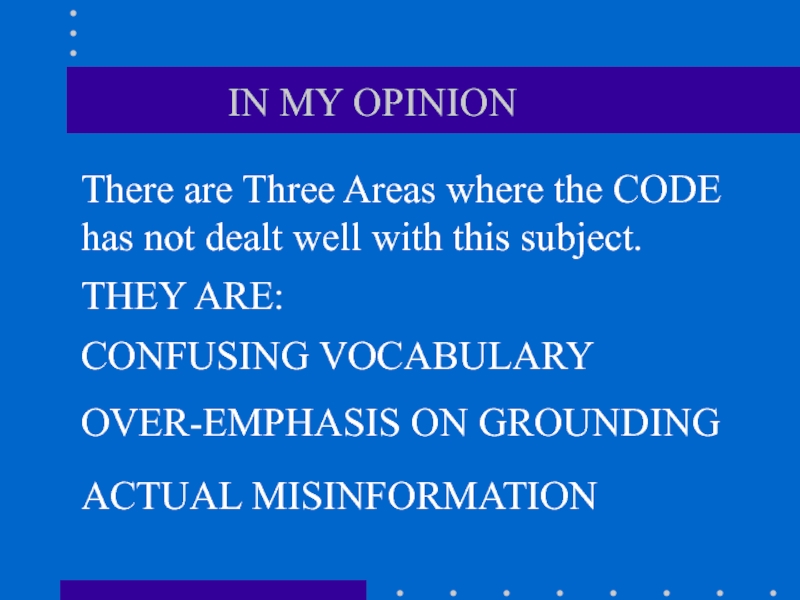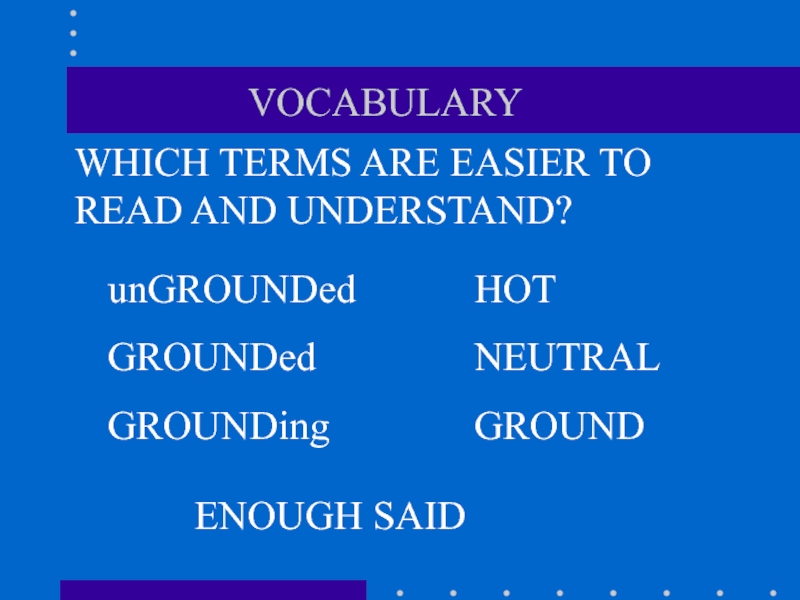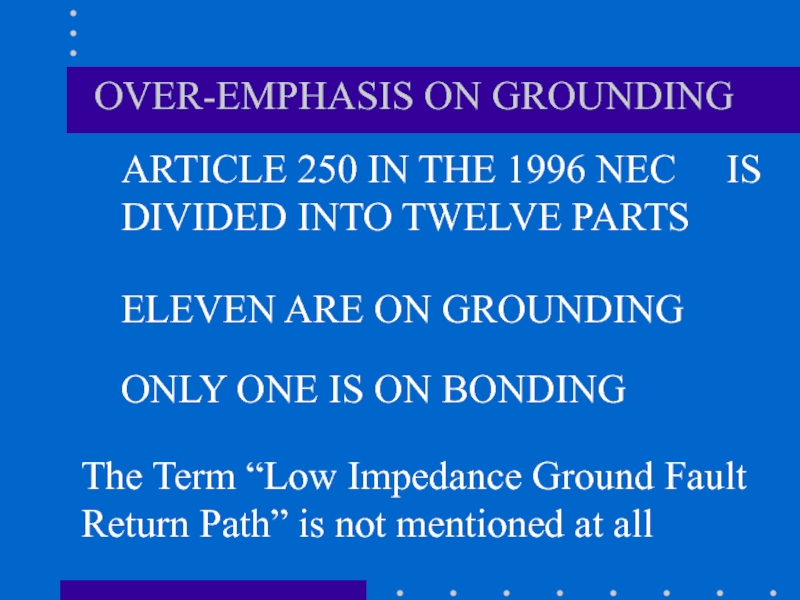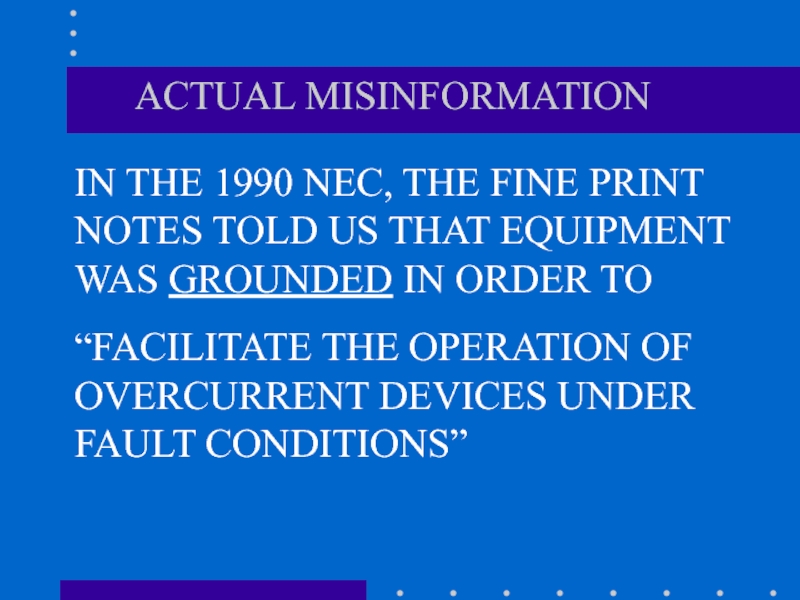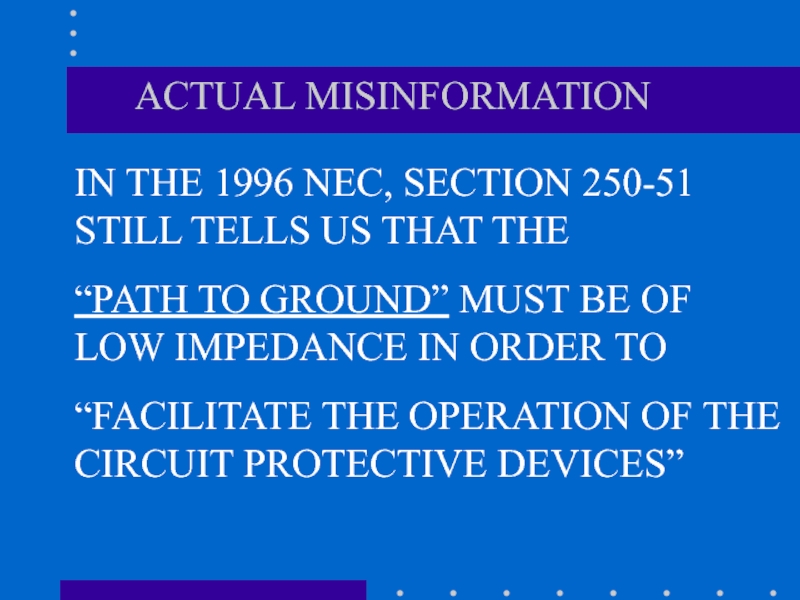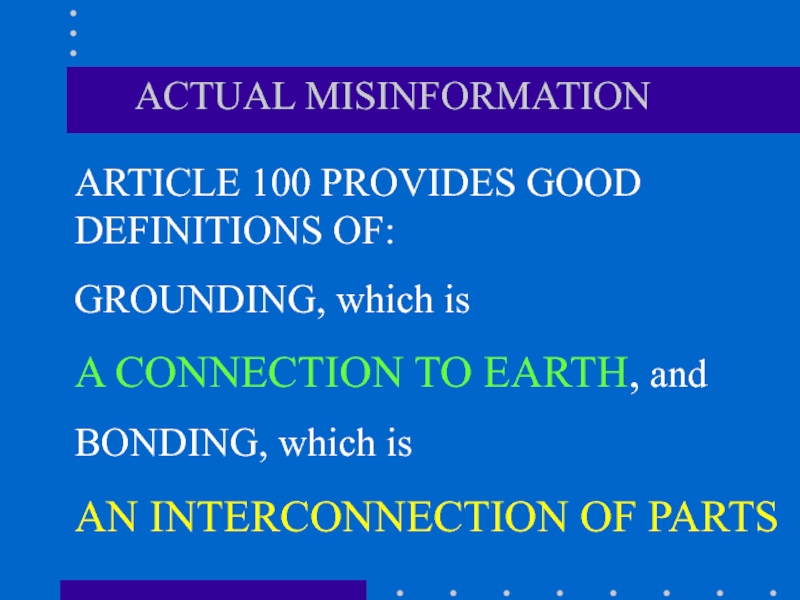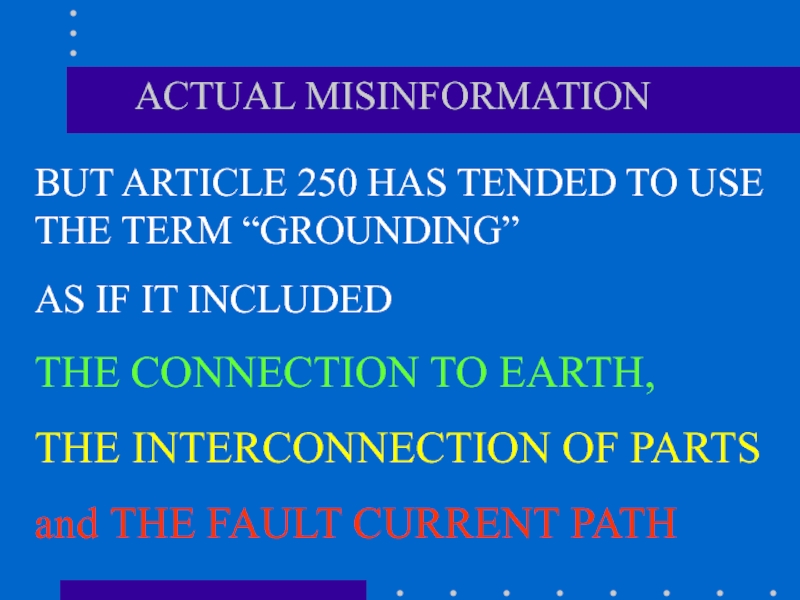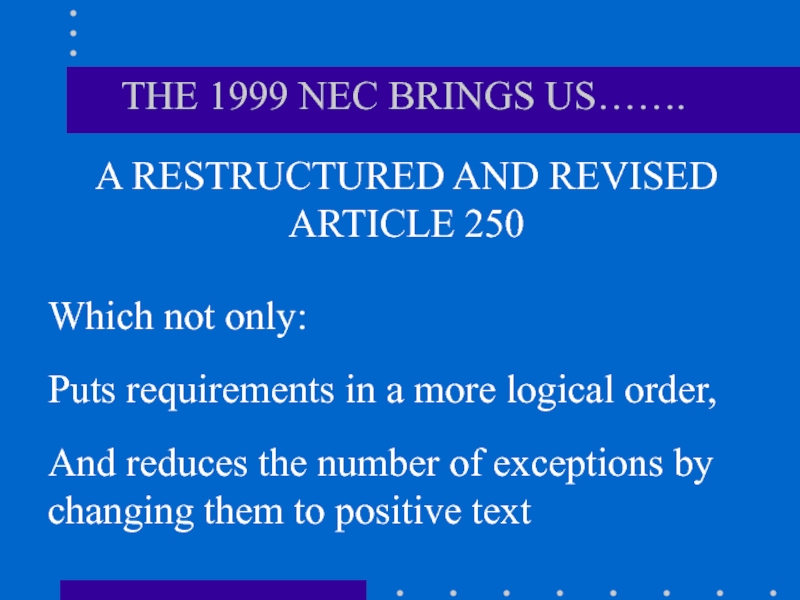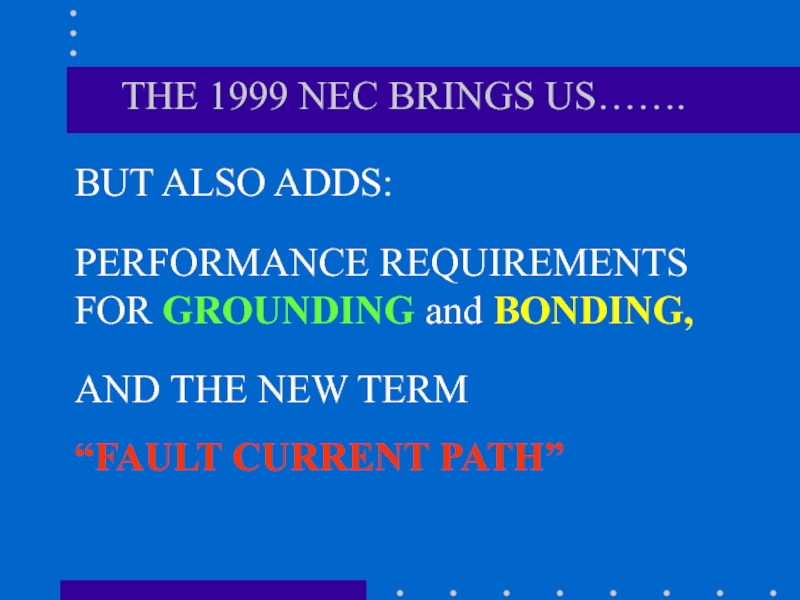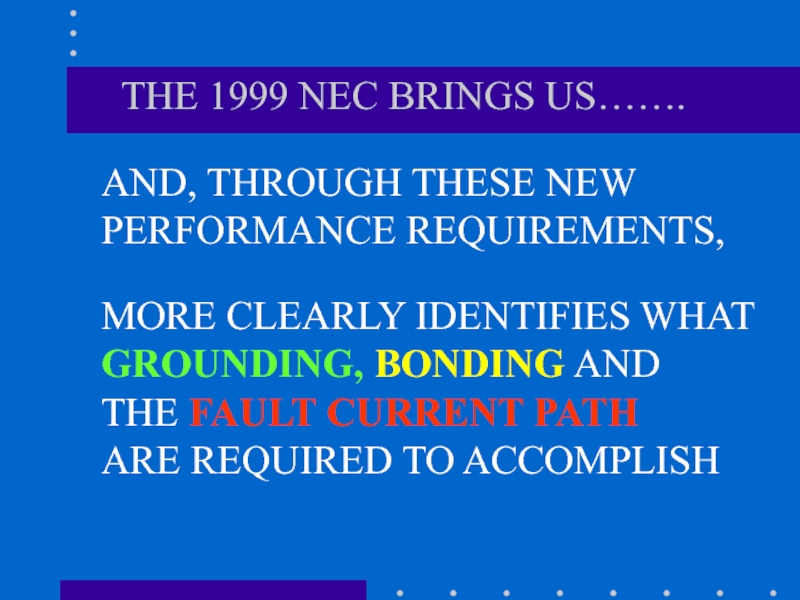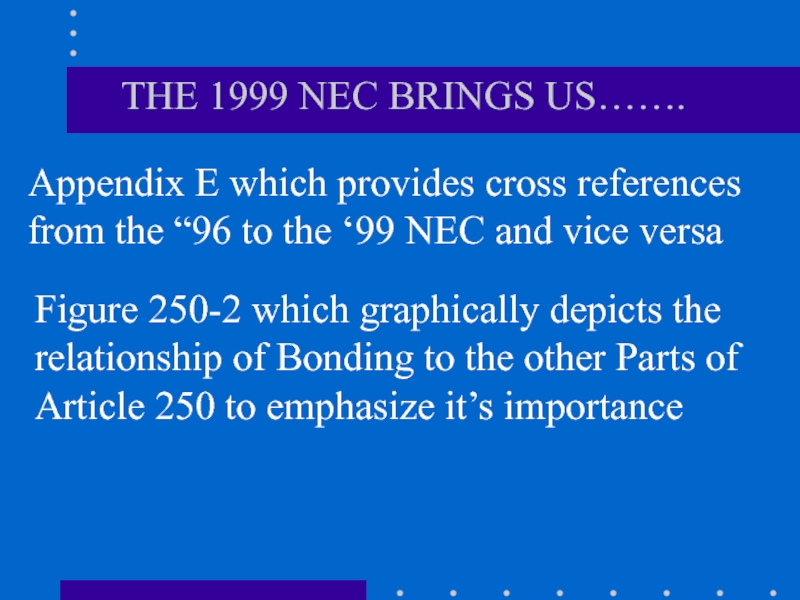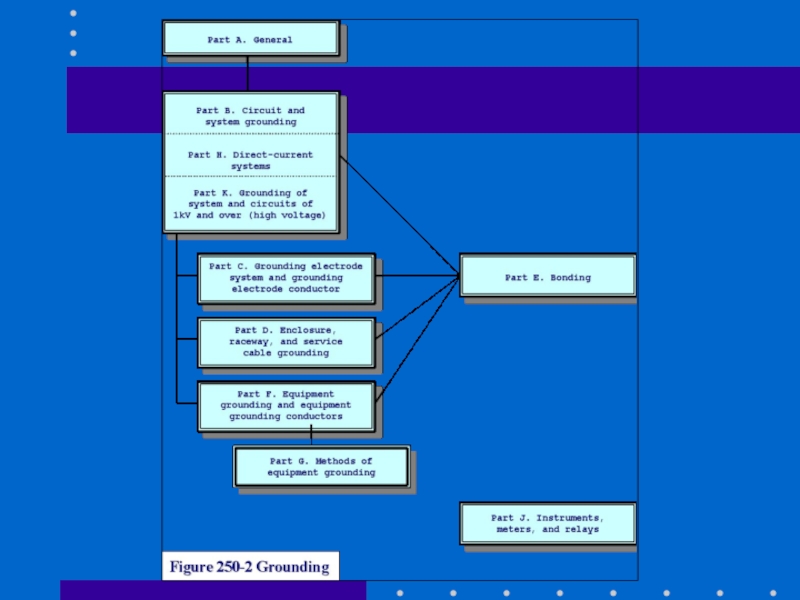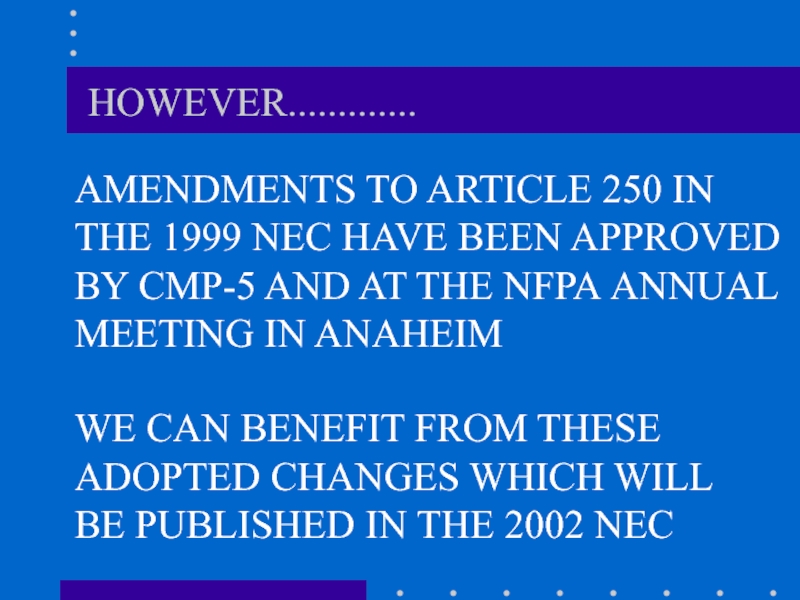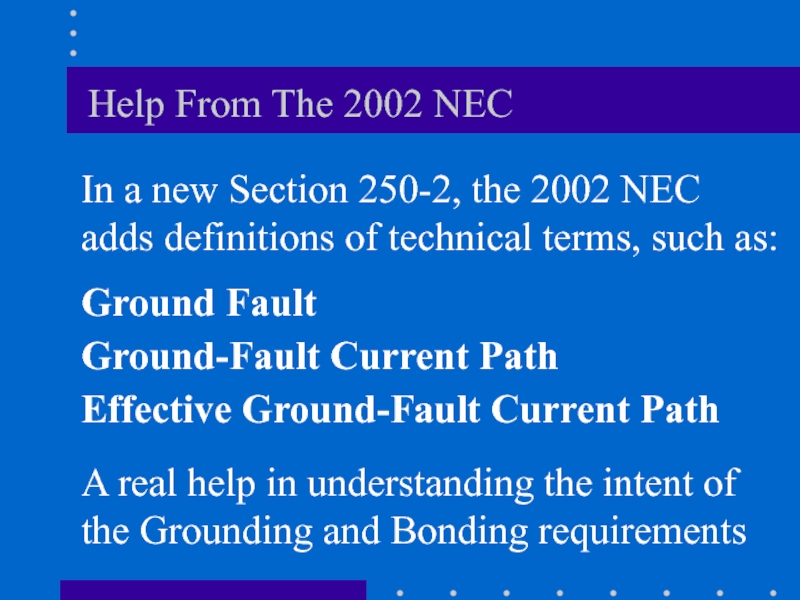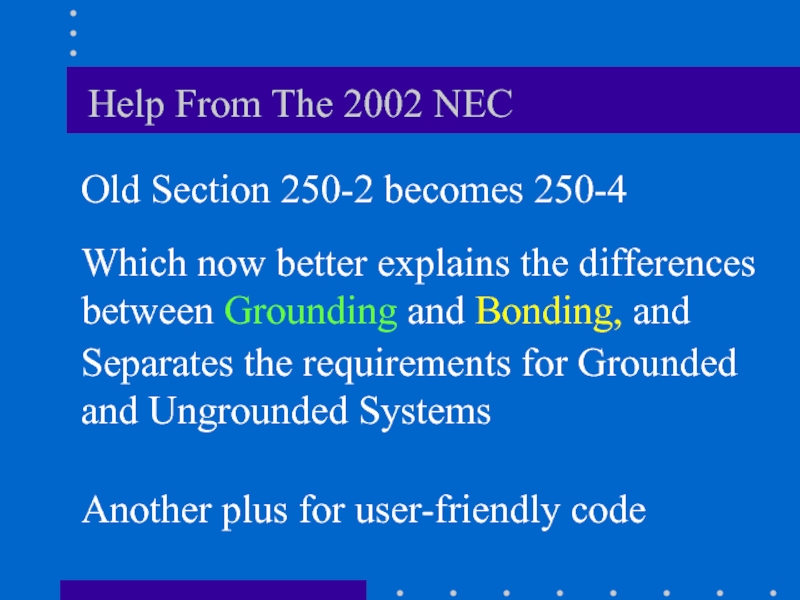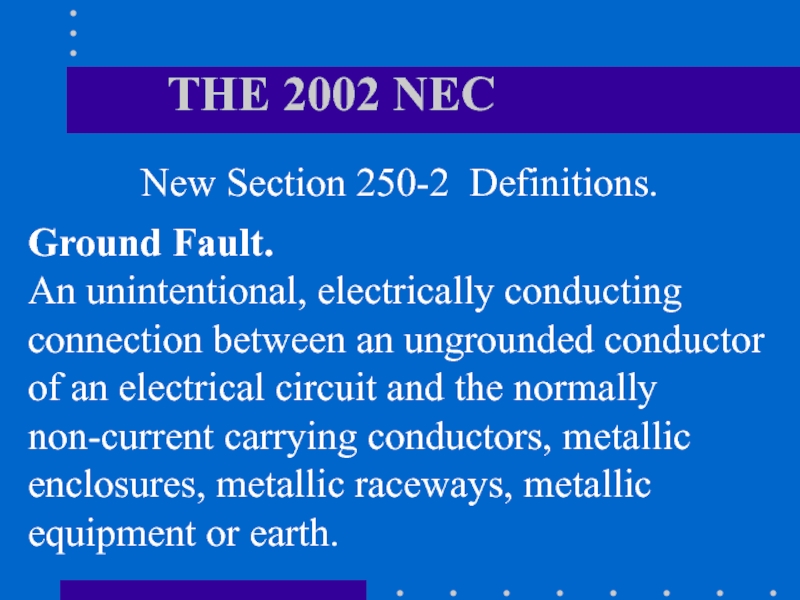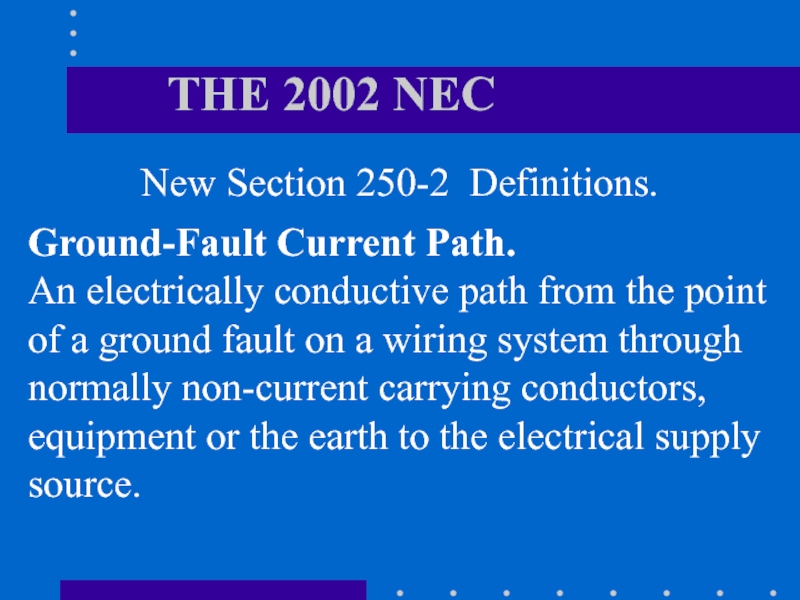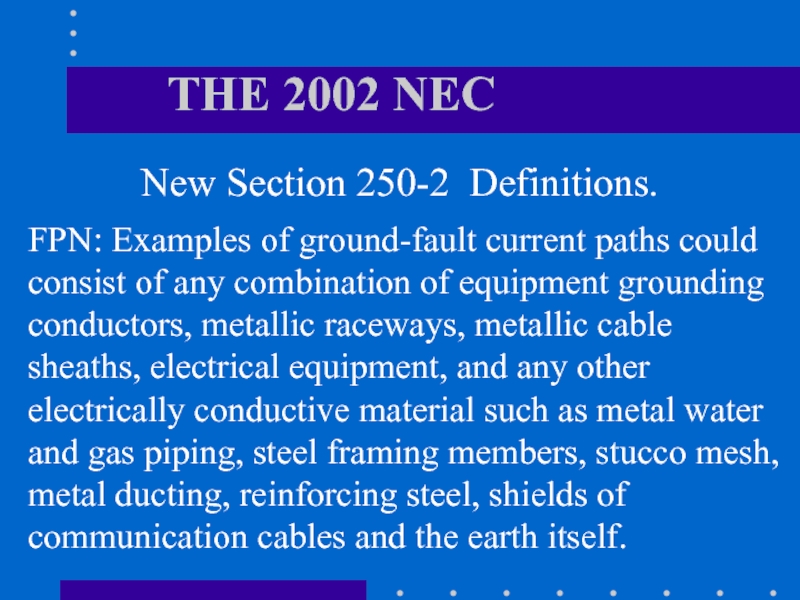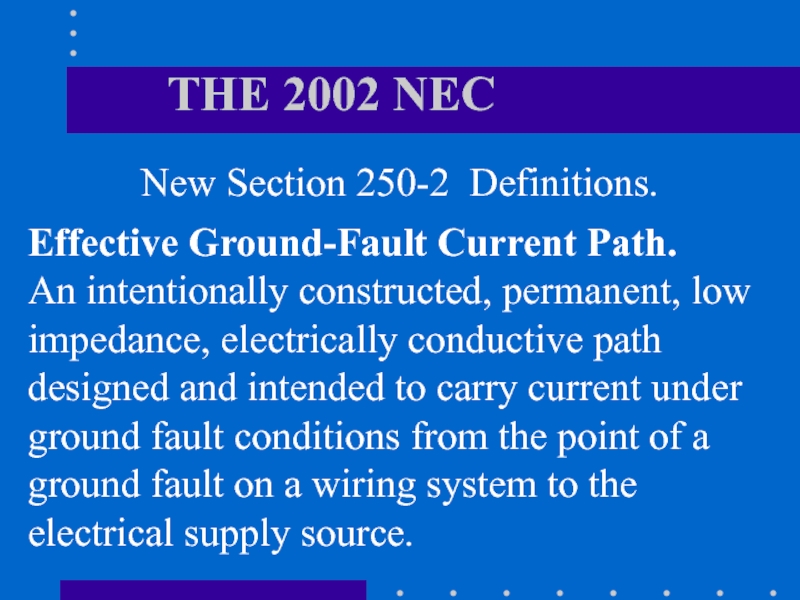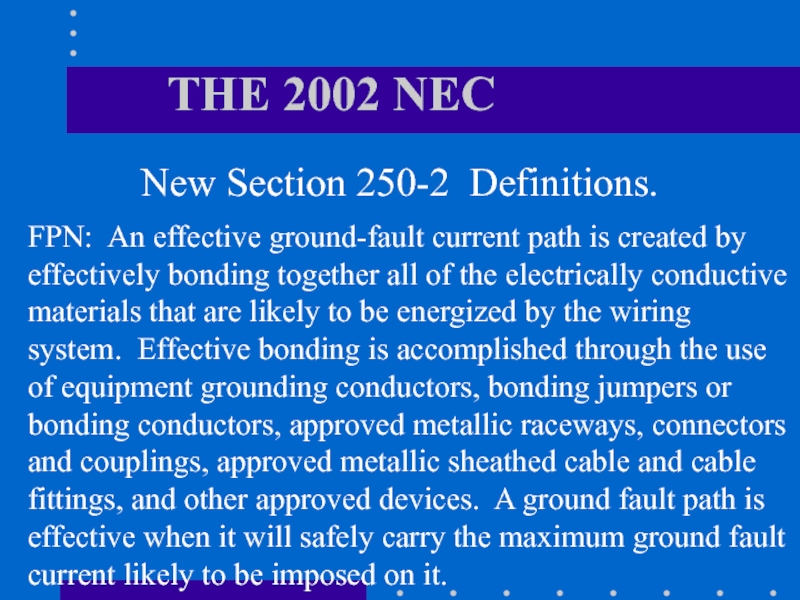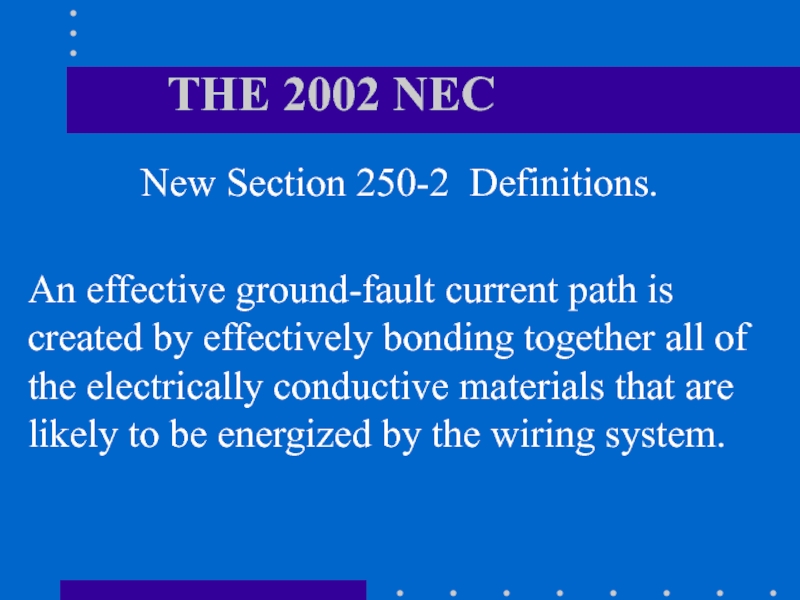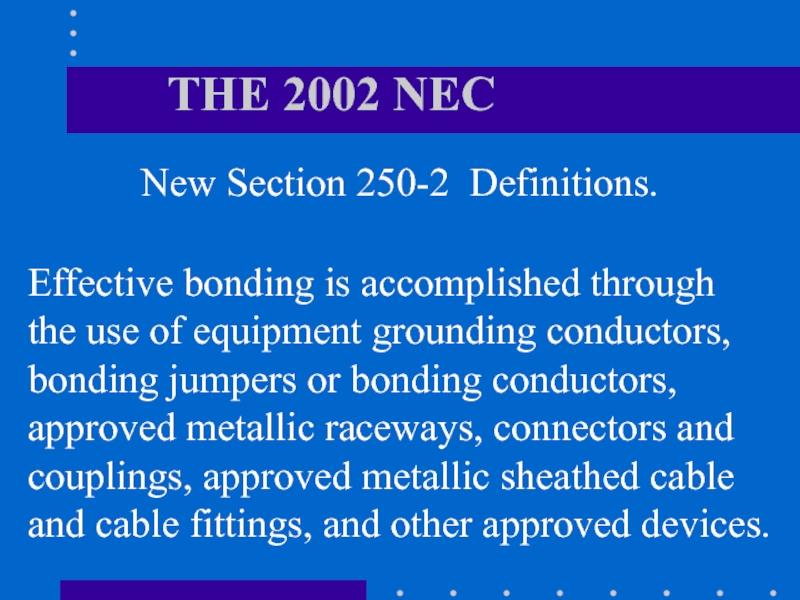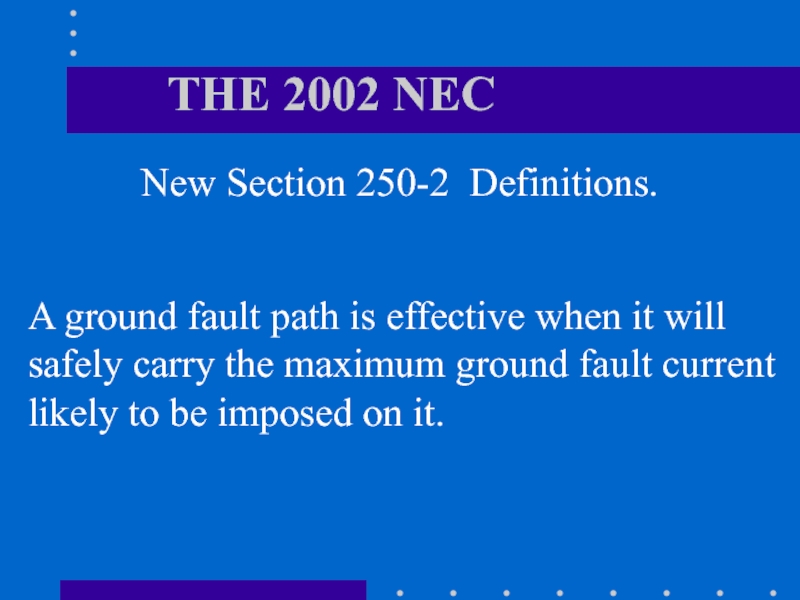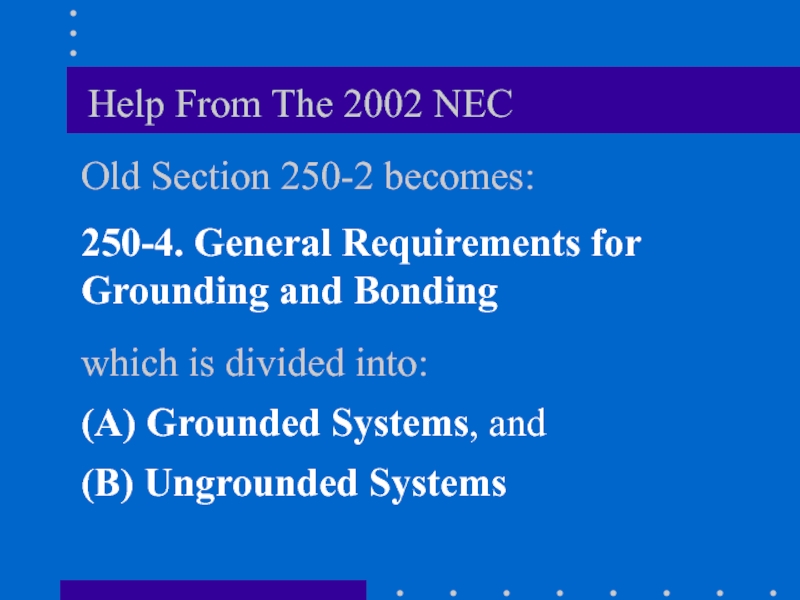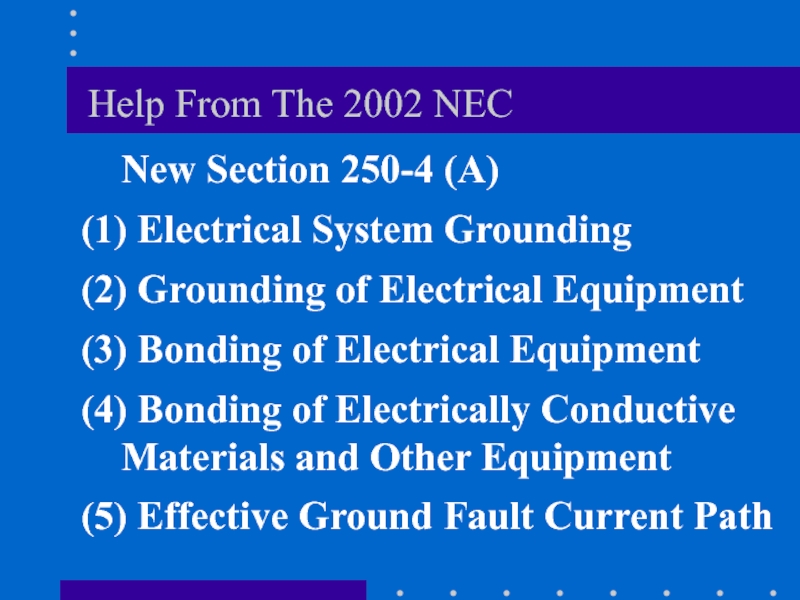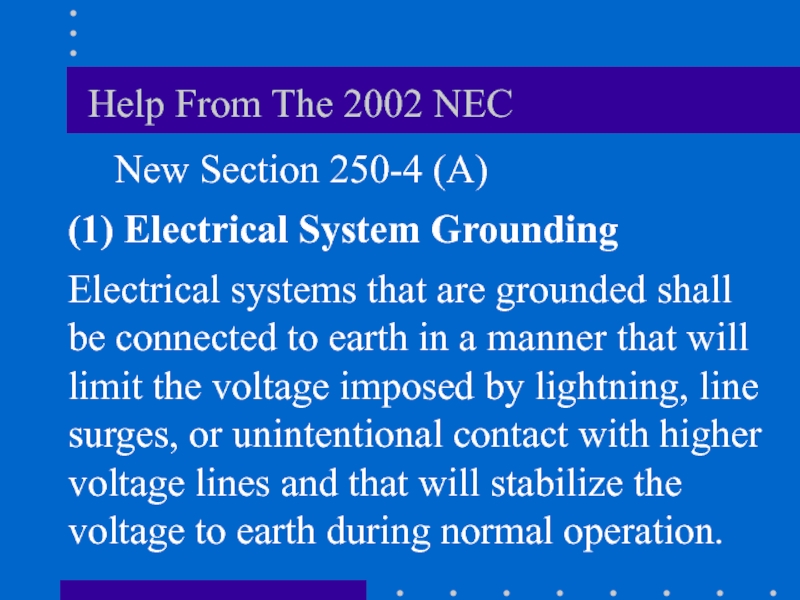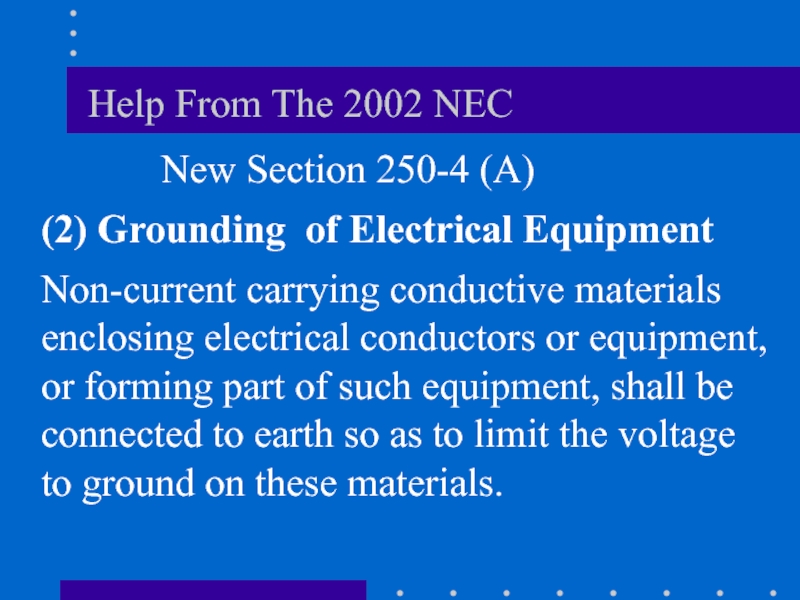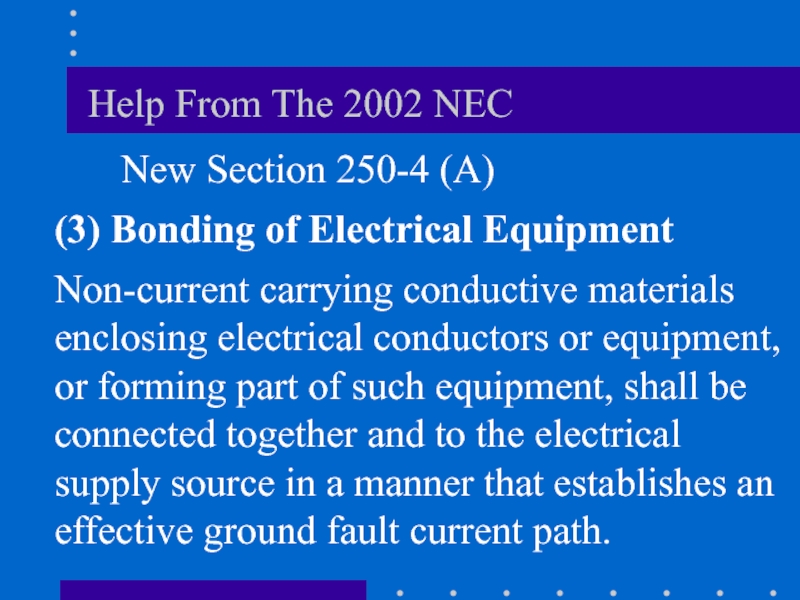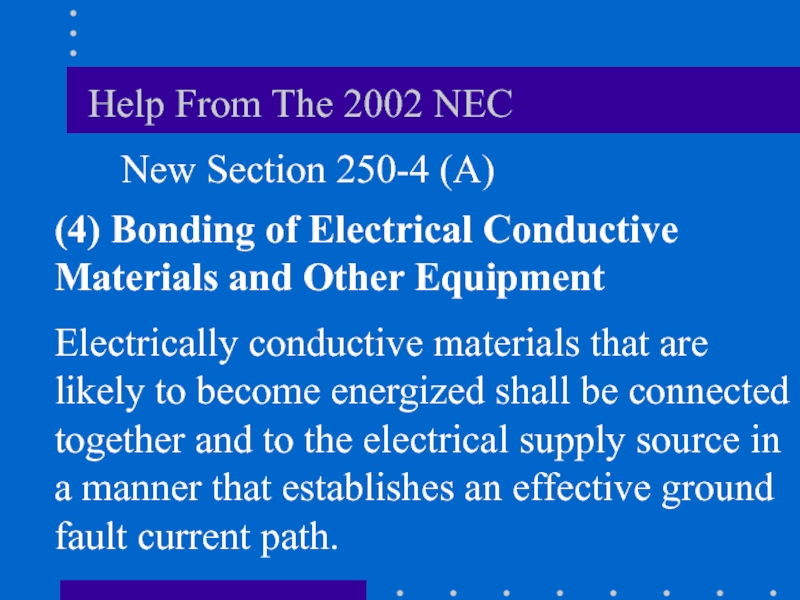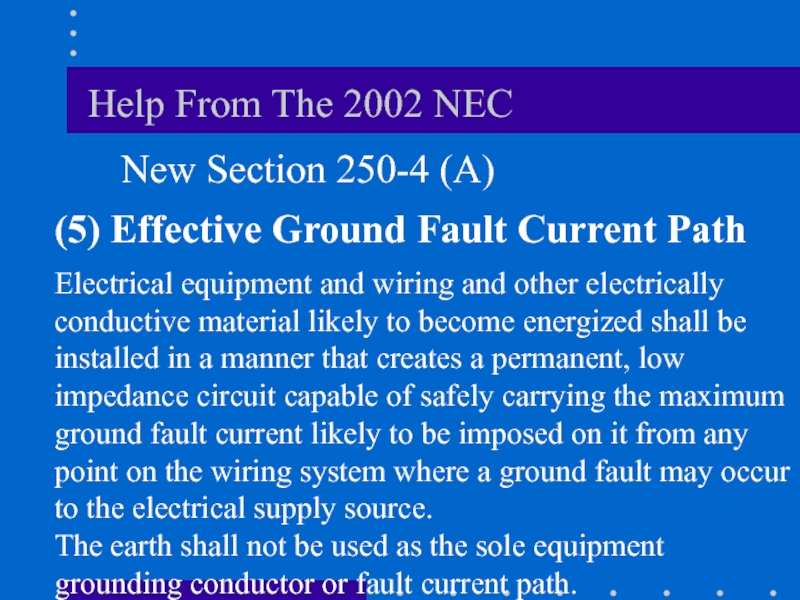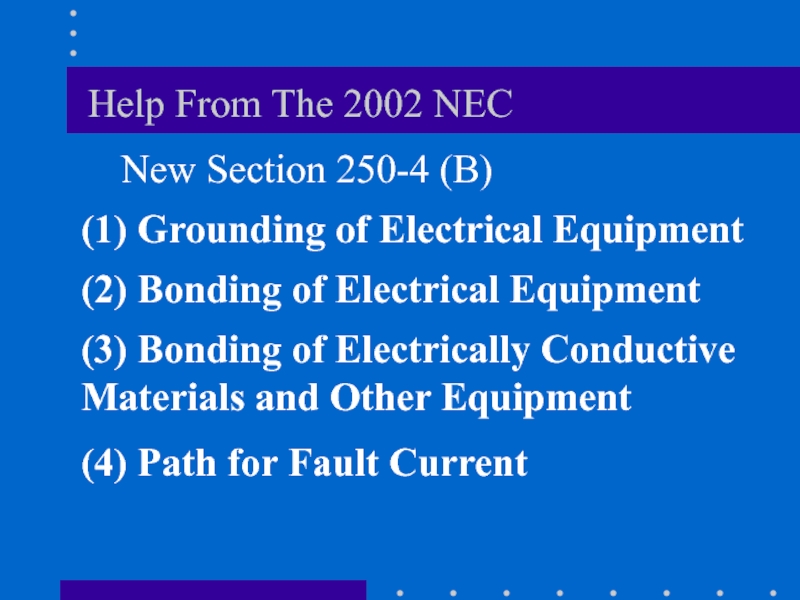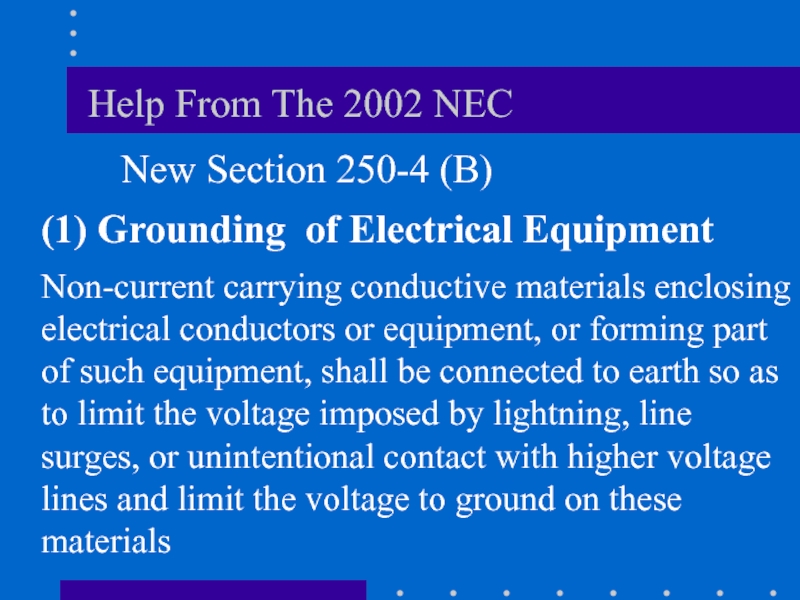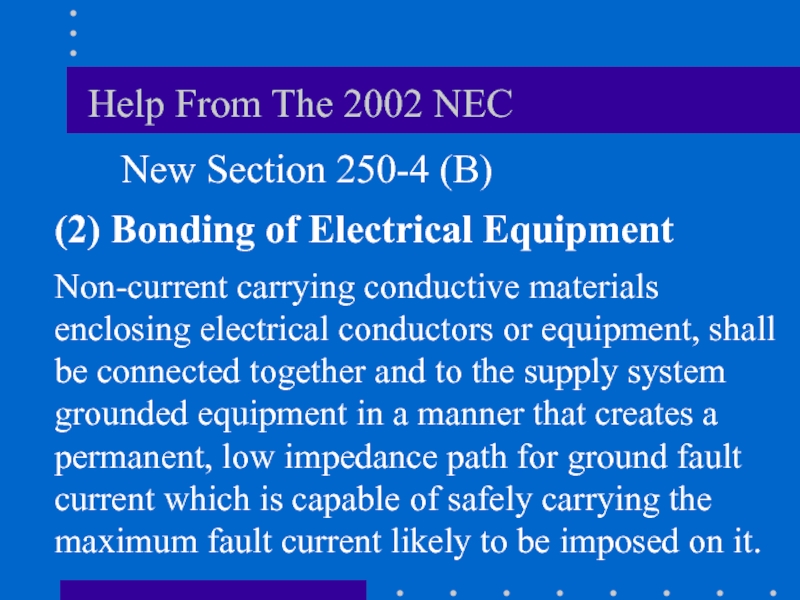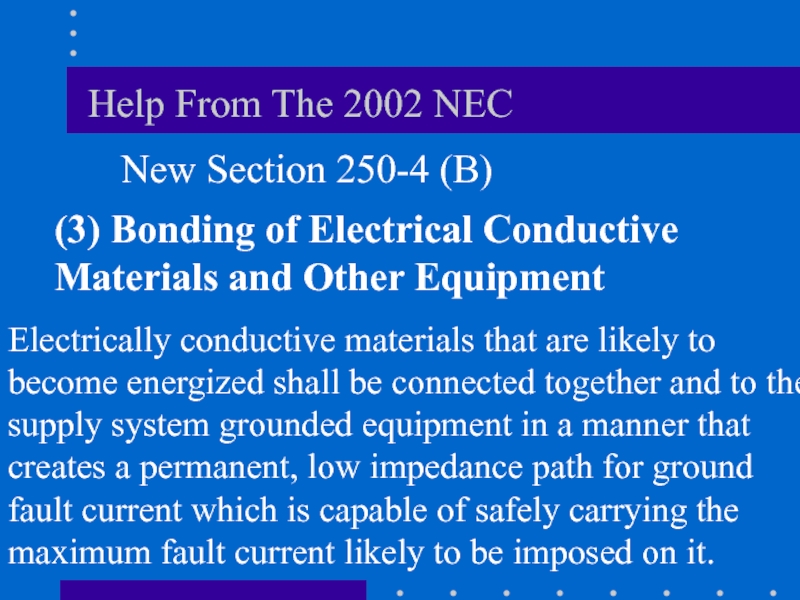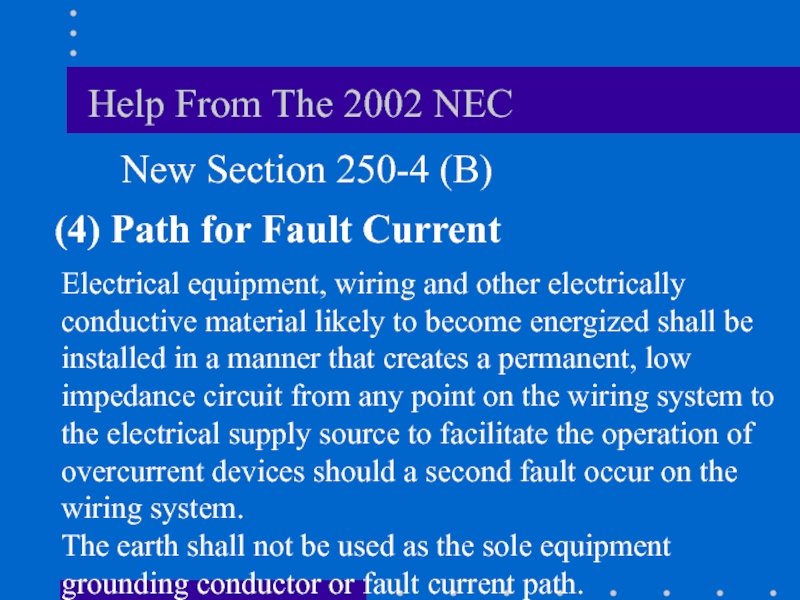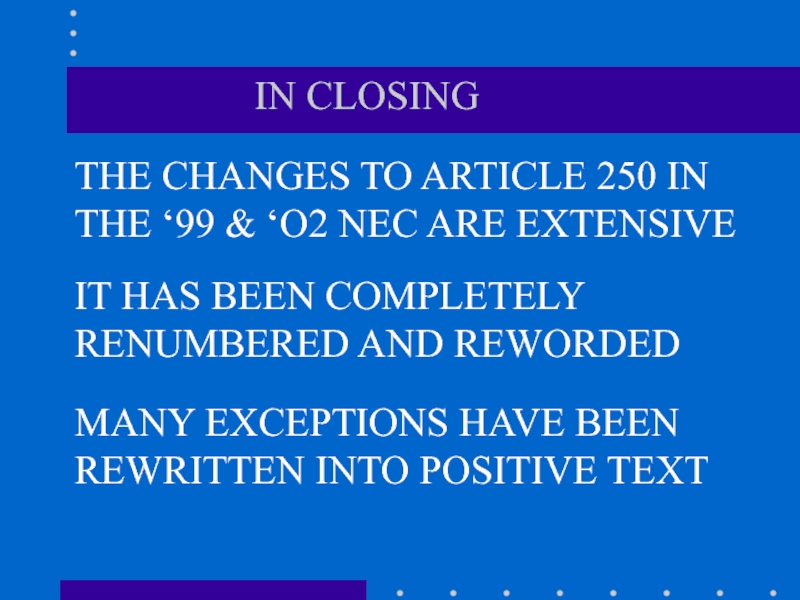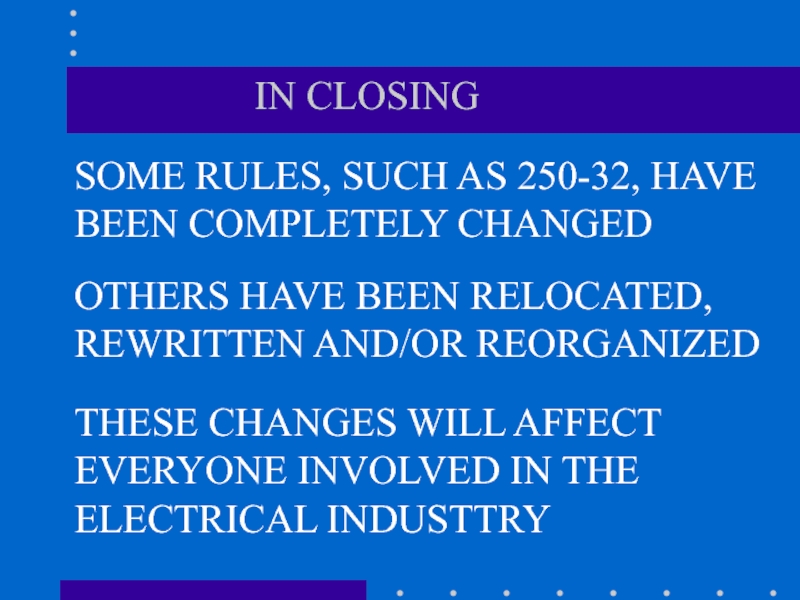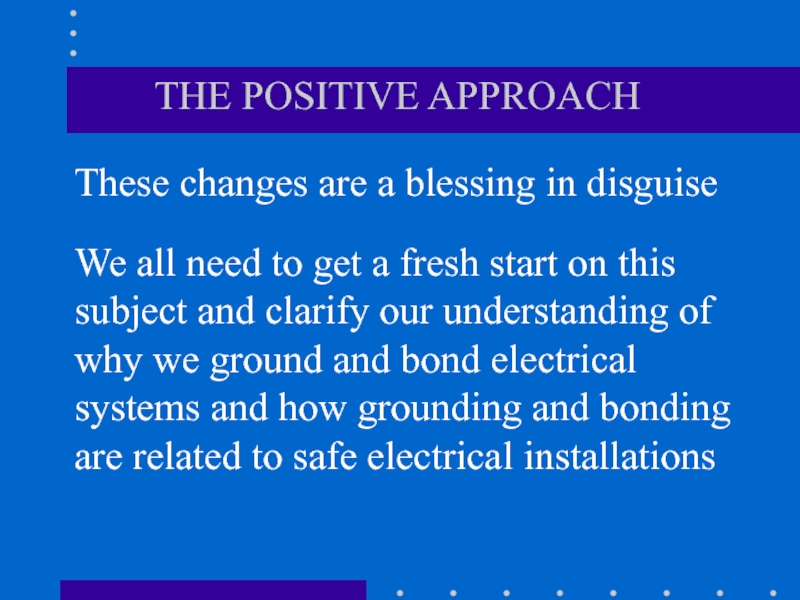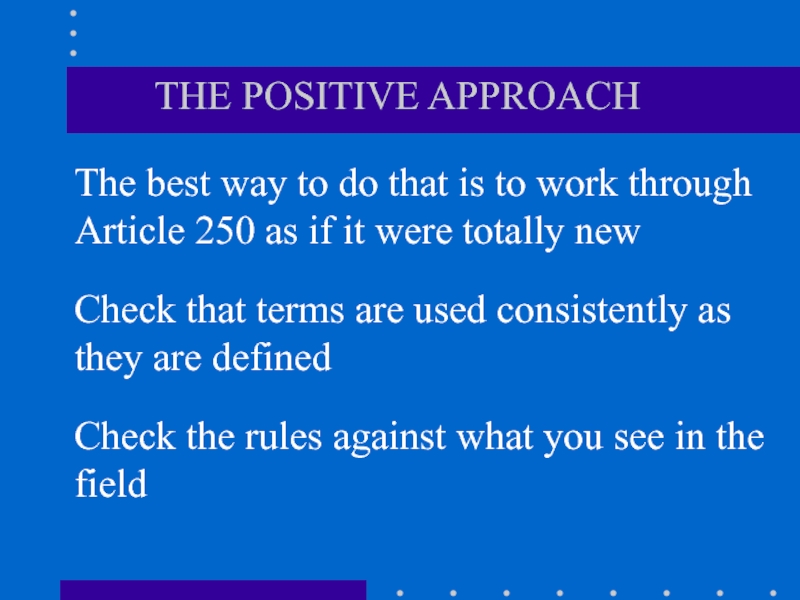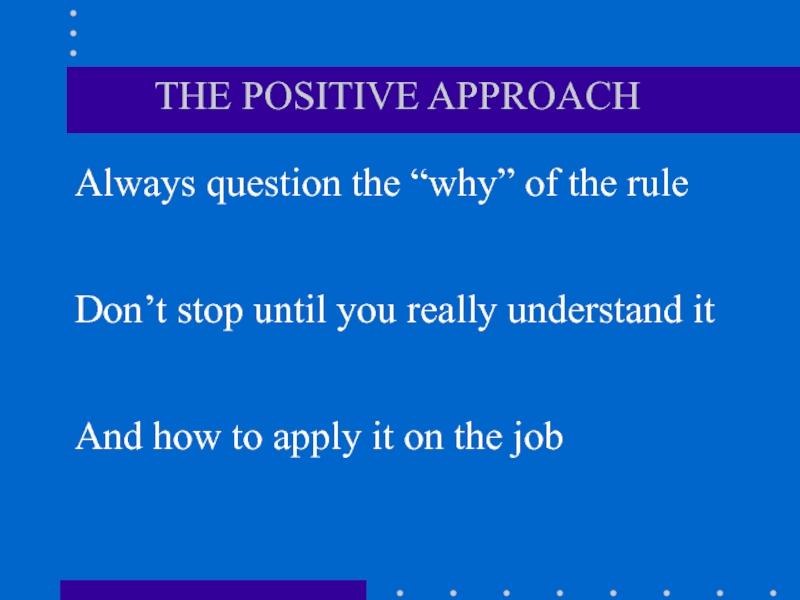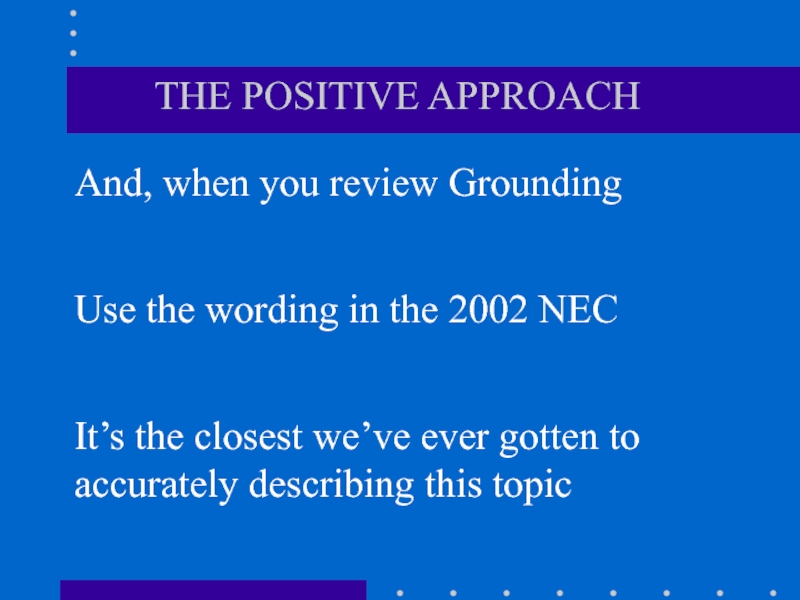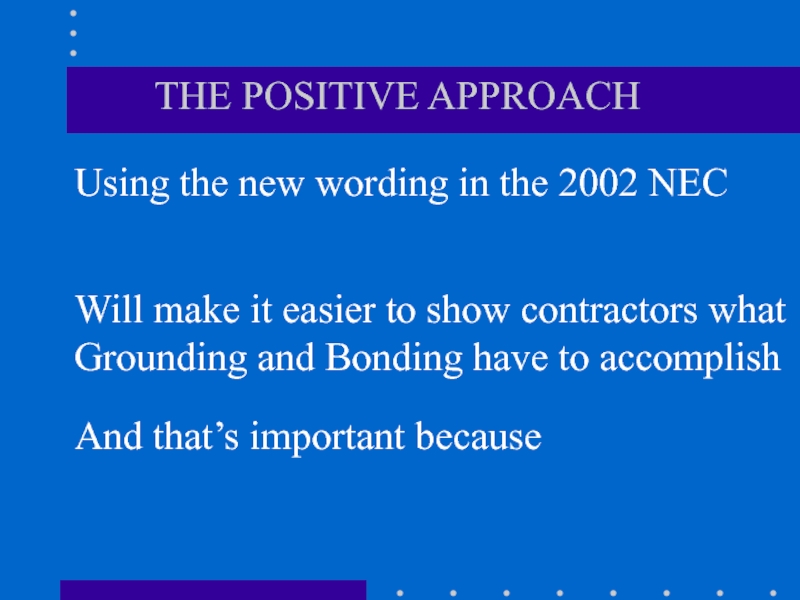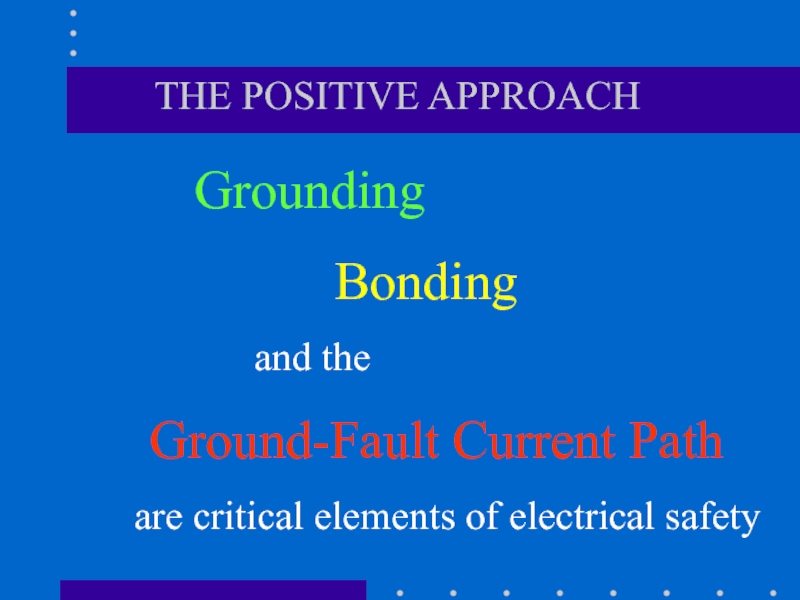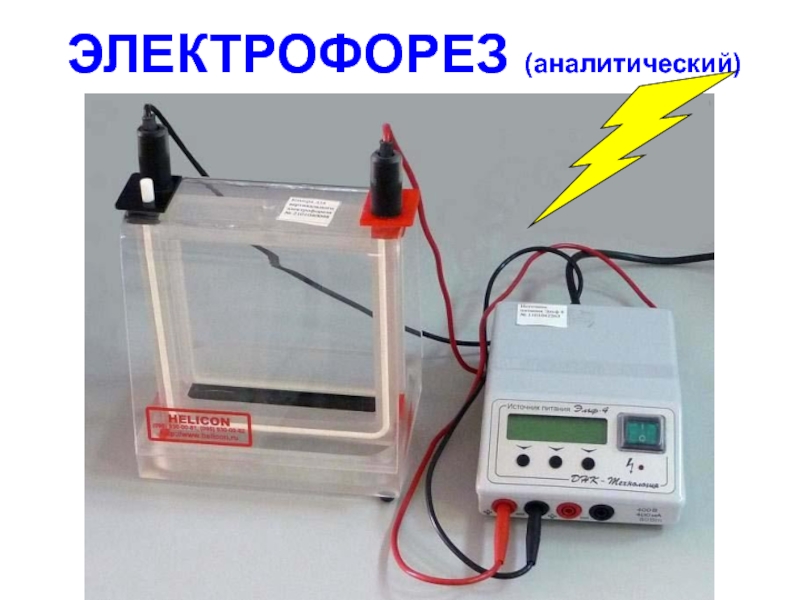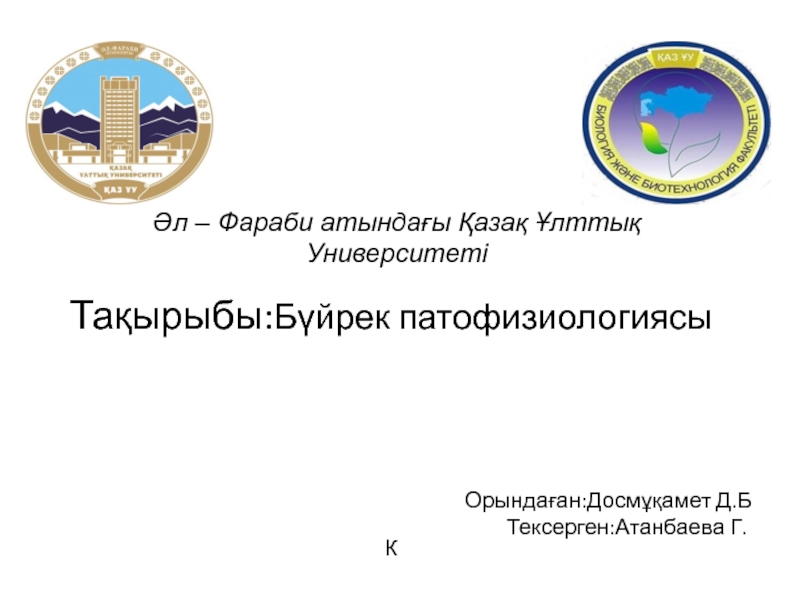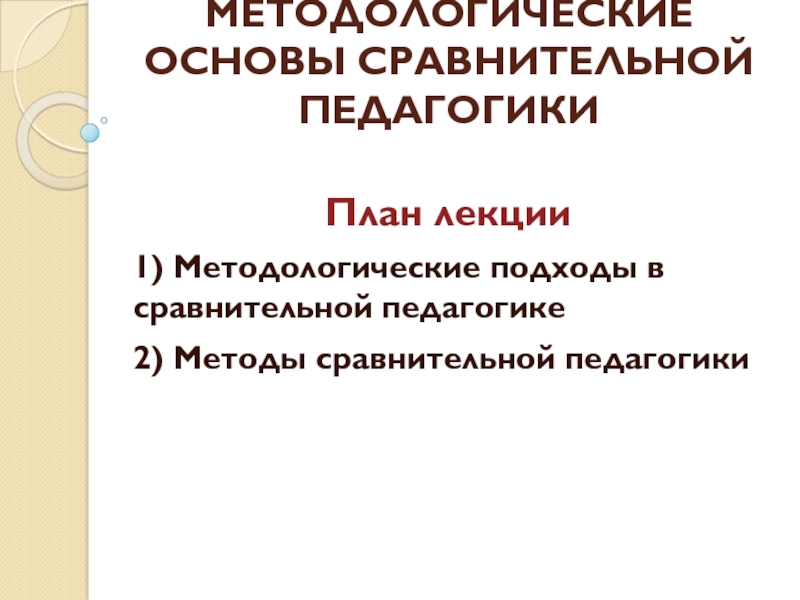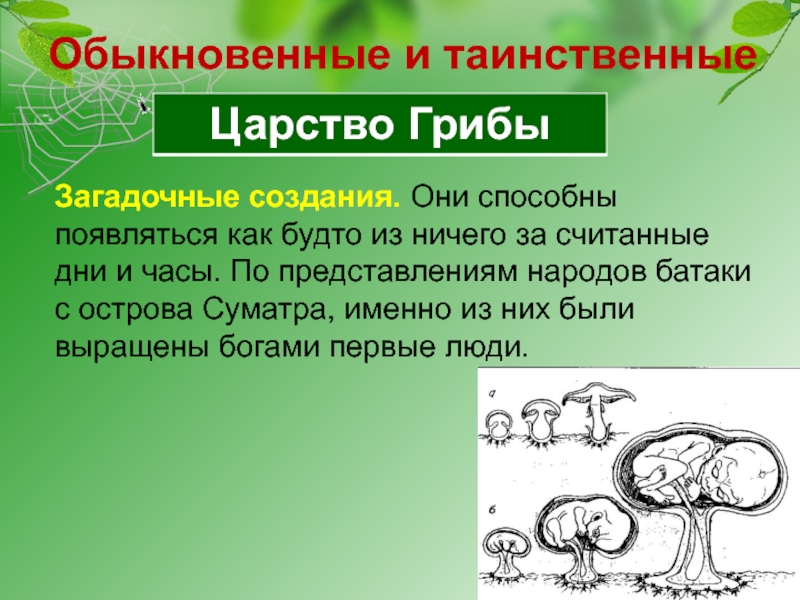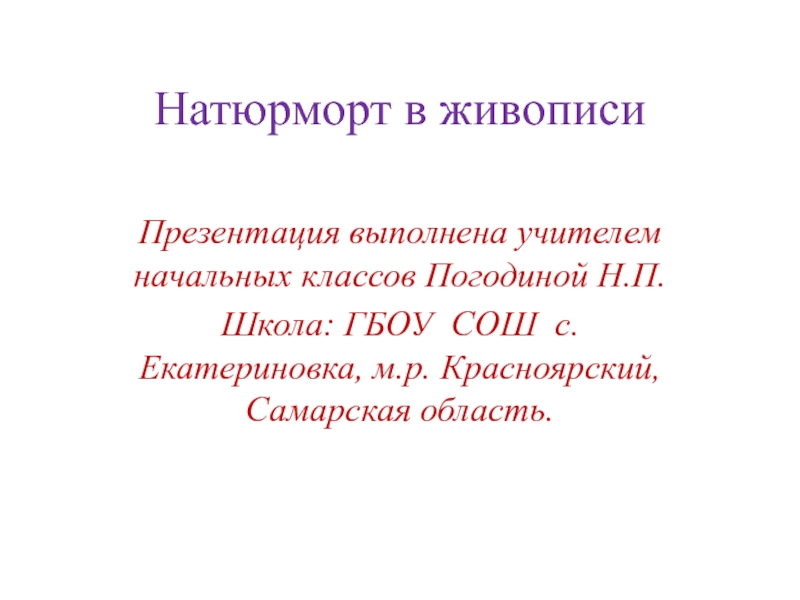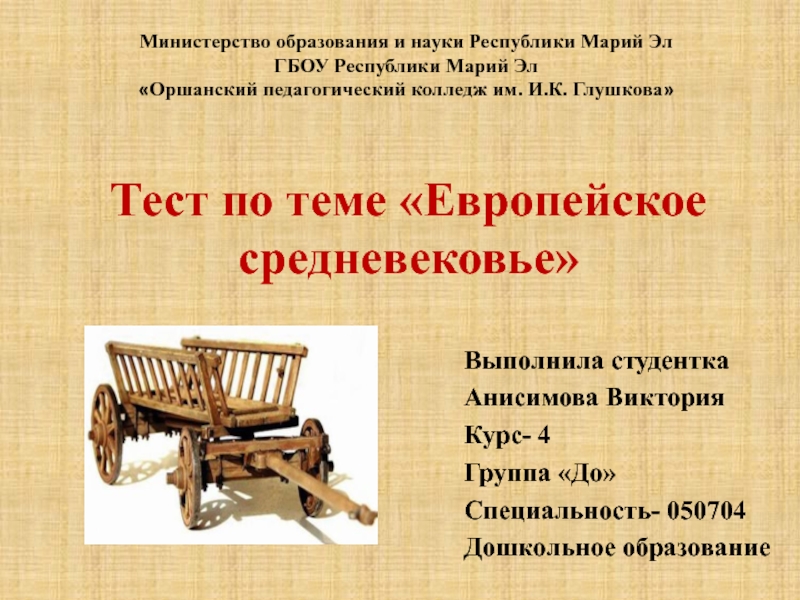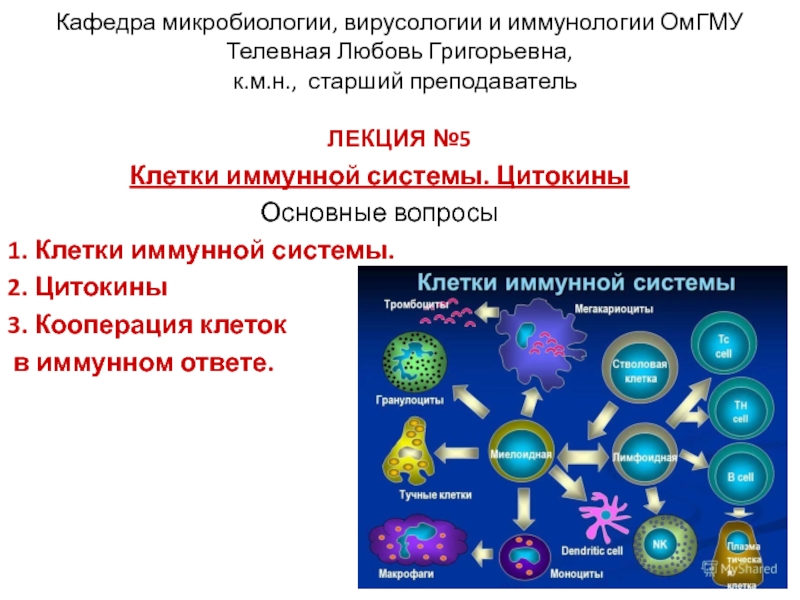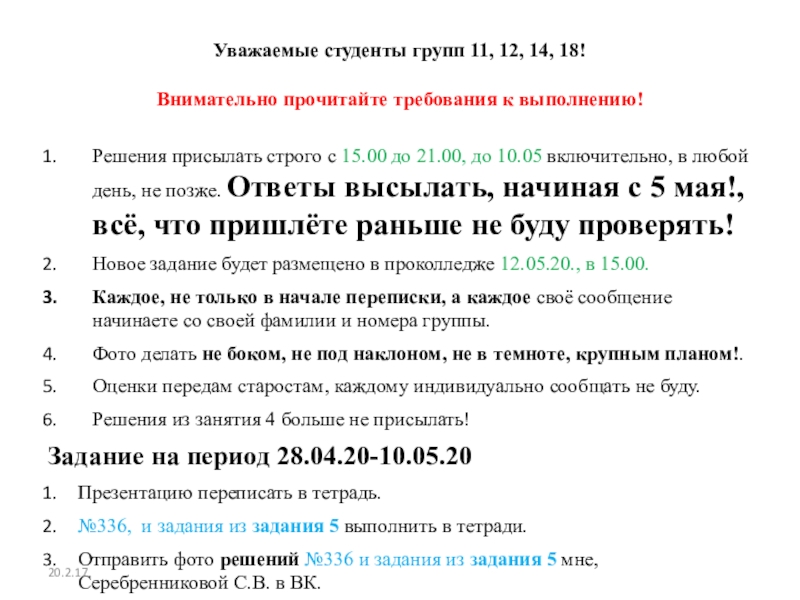Разделы презентаций
- Разное
- Английский язык
- Астрономия
- Алгебра
- Биология
- География
- Геометрия
- Детские презентации
- Информатика
- История
- Литература
- Математика
- Медицина
- Менеджмент
- Музыка
- МХК
- Немецкий язык
- ОБЖ
- Обществознание
- Окружающий мир
- Педагогика
- Русский язык
- Технология
- Физика
- Философия
- Химия
- Шаблоны, картинки для презентаций
- Экология
- Экономика
- Юриспруденция
G R O U N D I N G AND THE N E C THE SUBJECT
Содержание
- 1. G R O U N D I N G AND THE N E C THE SUBJECT
- 2. THE SPEAKERBOB LUDECKEMember IAEICA Certified ElectricianLic. Electrical
- 3. Thomas E. TrainorChief Electrical Inspector
- 4. Member of the original NFPA Task Group
- 5. The ‘99 NECCompletely ReorganizedExceptions MinimizedAnd Most Importantly.......Performance Requirements Added
- 6. Prescriptive vs PerformanceNEC rules are typically Prescriptive
- 7. Prescriptive vs PerformanceA Performance Rule is descriptive
- 8. Why is this Important?Grounding continues to be
- 9. Why is this Important?It is my considered
- 10. TYPICAL CIRCUIT OPERATIONOnly four things can happen
- 11. HOW DOES GROUNDING FIT IN? As long
- 12. TA circuit consisting of a transformer,
- 13. HOW DOES GROUNDING FIT IN?Under an overload
- 14. HOW DOES GROUNDING FIT IN?Under a short
- 15. HOW DOES GROUNDING FIT IN?Under a ground
- 16. RETURN PATH REQUIREDTHE OVERCURRENT DEVICE CAN ONLY
- 17. L O A D
- 18. L O A D
- 19. L O A D
- 20. L O A D
- 21. L O A D
- 22. PATH OF CURRENT FLOW - NORMAL OPERATIONAnd
- 23. PATH OF CURRENT FLOW - NORMAL OPERATIONWhat
- 24. PATH OF CURRENT FLOW - NORMAL OPERATIONThe
- 25. THINGS YOU CAN COUNT ON
- 26. OVERLOAD AND SHORT CIRCUIT CONDITIONSHow is our
- 27. OVERLOAD AND SHORT CIRCUIT CONDITIONSTHE OVERCURRENT DEVICEPROTECTS
- 28. SUMMARIZING TO THIS POINTCIRCUIT CONDITIONPROTECTION PROVIDED BY:GROUNDING?O/C PROT?NORMAL OPERATIONNONOOVERLOAD CONDITIONNOYESSHORT CIRCUIT CONDITIONNOYES
- 29. So lets talk about a Ground Fault
- 30. GROUND FAULT CONDITIONWhat happens if the hot
- 31. L O A D
- 32. GROUND FAULT CONDITIONNONOT AT ALLAND WHY NOT?
- 33. GROUND FAULT CONDITIONBecause the transformer we’re looking
- 34. GROUND FAULT CONDITIONYes, that was a “Trick”
- 35. THINGS YOU CAN COUNT
- 36. GROUND FAULT CONDITIONSo our friend in this
- 37. GROUND FAULT CONDITIONWhat do we know about
- 38. GROUND FAULT CONDITIONTHEY’RE GROUNDED And, with this
- 39. SO WHY ARE THEY GROUNDED?To minimize the
- 40. GROUND FAULT CONDITIONBecause utility transformers are grounded,
- 41. GROUND FAULT CONDITIONCan we protect our friend
- 42. GROUND FAULT CONDITIONGrounding our equipment provides a
- 43. L O A D
- 44. L O A D
- 45. We need to open a 15A Circuit
- 46. GROUND FAULT CONDITIONThe voltage is 120V. We
- 47. Assuming a minimum of 5 ohms resistance
- 48. THEREFORE, USING OHM’S LAW:FAULT CURRENT PATHE =
- 49. ONLY FAULT CURRENT PATH12AMPS
- 50. WITH EQUIPMENT GROUNDED L O A D
- 51. GROUNDING CONCLUSIONDOES NOT PROTECTEQUIPMENT OR PERSONNEL FROM A GROUND FAULT
- 52. THE BONDING CONNECTIONThe vital connection left out
- 53. Every piece of conductive metal which is
- 54. THE BONDING CONNECTIONThese connections create an electrically
- 55. THE BONDING CONNECTIONThese bonding connections let us
- 56. THE BONDING CONNECTIONBonding provides a third path
- 57. We need to open a 15A Circuit
- 58. The resistance in this path includes
- 59. THE BONDING CONNECTION L O A D
- 60. THE BONDING CONNECTION L O A D
- 61. FAULT CURRENT PATHUSING OHM’S LAW:E = I
- 62. THE BONDING CONNECTIONThe Fault Current Return Path
- 63. THE BONDING CONNECTIONTHIS PATH DOES NOT RELY
- 64. CONCLUSIONTHE OVERCURRENT DEVICE PROTECTS AGAINST GROUND FAULT
- 65. IN REVIEWGROUNDING IS A CONNECTION TO EARTHINTENDED TO PROTECT OURELECTRICAL SYSTEM FROMLIGHTNING AND HIGH VOLTAGE
- 66. IN REVIEWTHE OVERCURRENT DEVICEPROTECTS OUR ELECTRICAL SYSTEM FROM OVERLOAD AND SHORT CIRCUIT
- 67. IN REVIEWTHE OVERCURRENT DEVICEPROTECTS OUR ELECTRICAL SYSTEM FROM A GROUND FAULT CONDITIONIF…….
- 68. IN REVIEWPROPER BONDING HAS CREATEDAN ELECTRICALLY CONTINOUS,
- 69. SO WHAT’S THE PROBLEM?WHY DOES “GROUNDING” CONTINUE TO BE A SUBJECT OF MYSTERY AND CONFUSION?
- 70. IN MY OPINIONThere are Three Areas where
- 71. VOCABULARYWHICH TERMS ARE EASIER TO READ AND UNDERSTAND?unGROUNDedGROUNDedGROUNDingHOTNEUTRALGROUNDENOUGH SAID
- 72. OVER-EMPHASIS ON GROUNDINGARTICLE 250 IN THE 1996
- 73. ACTUAL MISINFORMATIONIN THE 1990 NEC, THE FINE
- 74. IN THE 1996 NEC, SECTION 250-51 STILL
- 75. ARTICLE 100 PROVIDES GOOD DEFINITIONS OF:GROUNDING, which
- 76. BUT ARTICLE 250 HAS TENDED TO USE
- 77. THE 1999 NEC BRINGS US…….A RESTRUCTURED AND
- 78. BUT ALSO ADDS:THE 1999 NEC BRINGS US…….PERFORMANCE
- 79. THE 1999 NEC BRINGS US…….AND, THROUGH THESE
- 80. THE 1999 NEC BRINGS US…….Appendix E which
- 81. Слайд 81
- 82. HOWEVER.............AMENDMENTS TO ARTICLE 250 IN THE 1999
- 83. Help From The 2002 NEC In a
- 84. Help From The 2002 NEC Old Section
- 85. THE 2002 NEC New Section 250-2 Definitions.
- 86. THE 2002 NEC New Section 250-2 Definitions.
- 87. THE 2002 NEC New Section 250-2 Definitions.
- 88. THE 2002 NEC New Section 250-2 Definitions.
- 89. THE 2002 NEC New Section 250-2 Definitions.
- 90. THE 2002 NEC New Section 250-2 Definitions.
- 91. THE 2002 NEC New Section 250-2 Definitions.
- 92. THE 2002 NEC New Section 250-2 Definitions.
- 93. Help From The 2002 NEC Old Section
- 94. Help From The 2002 NEC New
- 95. Help From The 2002 NEC New
- 96. Help From The 2002 NEC
- 97. Help From The 2002 NEC New
- 98. Help From The 2002 NEC New
- 99. Help From The 2002 NEC New
- 100. Help From The 2002 NEC New
- 101. Help From The 2002 NEC New
- 102. Help From The 2002 NEC New
- 103. Help From The 2002 NEC New
- 104. Help From The 2002 NEC New
- 105. IN CLOSINGTHE CHANGES TO ARTICLE 250 IN
- 106. IN CLOSINGSOME RULES, SUCH AS 250-32, HAVE
- 107. THE POSITIVE APPROACHThese changes are a blessing
- 108. THE POSITIVE APPROACHThe best way to do
- 109. THE POSITIVE APPROACHAlways question the “why” of
- 110. THE POSITIVE APPROACHAnd, when you review GroundingUse
- 111. THE POSITIVE APPROACHUsing the new wording in
- 112. THE POSITIVE APPROACH Grounding
- 113. THANK YOU FOR YOUR TIME AND ATTENTION
- 114. Скачать презентанцию
Слайды и текст этой презентации
Слайд 2THE SPEAKER
BOB LUDECKE
Member IAEI
CA Certified Electrician
Lic. Electrical Contractor
CSLB Industry Expert
CSLB
Subject Matter Expert
Hands on Electrician Since 1974
Слайд 3Thomas E. Trainor
Chief Electrical Inspector
City of San Diego, California
Representing
IAEI on CMP 7 Member - NFPA
Member - U.L. Electrical Council
SPECIAL THANKS TO
Слайд 4Member of the original NFPA Task Group on the
Useability of the National Electrical Code
Chaired the sub-committee assigned to review Article 250 and make recommendations to improve it’s “useability”
ALSO GUILTY OF:
Слайд 5The ‘99 NEC
Completely Reorganized
Exceptions Minimized
And Most Importantly.......
Performance Requirements Added
Слайд 6Prescriptive vs Performance
NEC rules are typically Prescriptive
A Prescriptive Rule
tells you what to do
But, what it doesn’t tell you
is.....Why you’re doing it!
Слайд 7Prescriptive vs Performance
A Performance Rule is descriptive
It describes what
has to be accomplished
And this description will most generally
Explain the
intent of the rule Слайд 8Why is this Important?
Grounding continues to be a Mystery
Proper
Grounding is vital for an installation
To protect from Fire
and Electrocution Improper Grounding is Commonplace
Слайд 9Why is this Important?
It is my considered opinion,
The intent
of the Grounding Rules
Will lead to better, safer installations
That a better understanding of
Слайд 10TYPICAL CIRCUIT OPERATION
Only four things can happen when a circuit
is energized.
It can operate normally
There can be an overload
There can
be a short circuitThere can be a ground fault
Слайд 11HOW DOES GROUNDING FIT IN?
As long as the circuit
is operating normally,
GROUNDING IS NOT NEEDED
As long as the circuit
is operating normally,GROUNDING IS NOT NEEDED
Слайд 12T
A circuit consisting of a transformer, 2 - 15A
conductors and a light bulb will operate just fine
(Check out the barn)Grounding is not needed
THE “UNGROUNDED” CIRCUIT
To make it work
or To make it safe
Слайд 13HOW DOES GROUNDING FIT IN?
Under an overload condition,
GROUNDING IS NOT
NEEDED
PROTECTION FROM OVERLOAD
IS PROVIDED BYTHE OVERCURRENT DEVICE
Note that current is only flowing on the conductors that we installed to carry current
Слайд 14HOW DOES GROUNDING FIT IN?
Under a short circuit condition,
GROUNDING IS
NOT NEEDED
PROTECTION AGAINST SHORT CIRCUIT IS PROVIDED BY
THE OVERCURRENT
DEVICEAgain, current is only flowing on the conductors we installed to carry current
Слайд 15HOW DOES GROUNDING FIT IN?
Under a ground fault condition,
GROUNDING IS
NOT NEEDED
PROTECTION AGAINST GROUND FAULT IS PROVIDED BY
THE OVERCURRENT
DEVICEHOWEVER……...
Слайд 16RETURN PATH REQUIRED
THE OVERCURRENT DEVICE CAN ONLY PROTECT AGAINST A
GROUND FAULT IF,
THE CIRCUIT IS INSTALLED SO THAT ALL
METAL PARTS ARE BONDED TOGETHER AND TO THE SERVICE NEUTRAL,WHICH CREATES A LOW RESISTANCE PATH FOR FAULT CURRENT TO RETURN TO THE SOURCE OF SUPPLY
Слайд 17 L
O
A
D
LETS LOOK AT A TYPICAL CIRCUIT
100’ of Overhead Distribution
Line,25’ of Service Drop,
25’ of Service Entrance Conductor,
100’ of Branch Circuit Conductors
Слайд 23PATH OF CURRENT FLOW - NORMAL OPERATION
What determines the amount
of current that will flow in this circuit?
L
O
AD
Слайд 24PATH OF CURRENT FLOW - NORMAL OPERATION
The Total RESISTANCE or
IMPEDANCE in the circuit will determine the amount of current
that will flow in the circuit L
O
A
D
Слайд 25 THINGS YOU CAN COUNT ON
OHMS LAW WORKS
We
can change the code, or
Hire a different contractor, or
Use romex
instead of EMT, butE = I x R still works
Слайд 26OVERLOAD AND SHORT CIRCUIT CONDITIONS
How is our circuit protected against
overload and short circuit?
L
O
A
D
Слайд 27OVERLOAD AND SHORT CIRCUIT CONDITIONS
THE OVERCURRENT DEVICE
PROTECTS THIS CIRCUIT FROM
BOTH
OVERLOAD AND SHORT CIRCUIT
15A Circuit Breaker
L
O
A
D Слайд 28SUMMARIZING TO THIS POINT
CIRCUIT CONDITION
PROTECTION PROVIDED BY:
GROUNDING?
O/C PROT?
NORMAL OPERATION
NO
NO
OVERLOAD CONDITION
NO
YES
SHORT
CIRCUIT CONDITION
NO
YES
Слайд 29So lets talk about a Ground Fault Condition
Which certainly sounds
like the one condition where Grounding would be important and
decide for ourselves whetherGrounding Provides Protection for Equipment or Personnel under a Ground Fault Condition
GROUND FAULT CONDITION
Слайд 30GROUND FAULT CONDITION
What happens if the hot conductor comes into
contact with our metal box?
L
O
A
D
Слайд 31 L
O
A
D
GROUND FAULT CONDITION
And our friend comes along and touches
it? IS HE IN JEOPARDY?
Слайд 33GROUND FAULT CONDITION
Because the transformer we’re looking at
IS NOT GROUNDED
so there is NO PATH THROUGH EARTH
for current to return to the transformer
L
O
A
D
Слайд 34GROUND FAULT CONDITION
Yes, that was a “Trick” question
Sorry about that
But
the intent was to make a point
L
O
AD
Слайд 35 THINGS YOU CAN COUNT ON
NO CIRCUIT
- NO CURRENT
CURRENT DOES NOT FLOW UNLESS THERE IS
A CONTINOUS PATH FROM ONE SIDE OF THE SOURCE OF SUPPLY TO THE OTHER CURRENT CANNOT TRAVEL THROUGH THE EARTH TO RETURN TO A TRANSFORMER UNLESS THE TRANSFORMER IS GROUNDED
Слайд 36GROUND FAULT CONDITION
So our friend in this situation is perfectly
safe
HOWEVER.....
L
O
A
D
Слайд 38GROUND FAULT CONDITION
THEY’RE GROUNDED
And, with this transformer grounded,
our friend is in serious jeopardy
L
O
A
D
Слайд 39SO WHY ARE THEY GROUNDED?
To minimize the damage caused if
lightning strikes their distribution lines, or
If a 12 KV line
drops onto a low voltage line,In addition, grounding the neutral of the distribution system stabilizes the voltage.
So, basically for the same reason we ground services at buildings.
Слайд 40GROUND FAULT CONDITION
Because utility transformers are grounded, we need to
do something to our equipment to keep our friend from
being electrocuted L
O
A
D
Слайд 41GROUND FAULT CONDITION
Can we protect our friend by grounding our
metal equipment? Lets take a look.
L
O
A
D
Слайд 42GROUND FAULT CONDITION
Grounding our equipment provides a second path for
fault current
L
O
A
D
Слайд 43 L
O
A
D
GROUND FAULT CONDITION
The first is through our friend to
earth and back to the transformerСлайд 44 L
O
A
D
GROUND FAULT CONDITION
The new second path is through our
metal equipment to earth and back to the transformerСлайд 45We need to open a 15A Circuit Breaker as quickly
as possible. This will require a fault current of 60A
to 75A. (4 to 5 times the rating of the breaker)We can use Ohm’s Law to find out how much current will flow on our new path.
FAULT CURRENT PATH
Слайд 46GROUND FAULT CONDITION
The voltage is 120V. We need to know
the resistance in this circuit to calculate current
L
O
AD
Слайд 47Assuming a minimum of 5 ohms resistance through each grounding
electrode, we know there is at least 10 ohms resistance
in the fault path that we created by grounding our equipment.FAULT CURRENT PATH
Слайд 48THEREFORE, USING OHM’S LAW:
FAULT CURRENT PATH
E = I x R
and Transposing, I = E / R
I (current) =
E(voltage) / R(resistance)and so, I = 120 / 10 = 12A
Слайд 50WITH EQUIPMENT GROUNDED
L
O
A
D
So the Overcurrent Device does not
openAnd we have fried our friend
Слайд 52THE BONDING CONNECTION
The vital connection left out of our discussion
until now is the bonding of metal equipment to the
service neutral L
O
A
D
Слайд 53Every piece of conductive metal which is a part of
our system or likely to become energized
Must be connected
together by an electrically continuous metal-to-metal contact or by an equipment grounding conductorTHE BONDING CONNECTION
Слайд 54THE BONDING CONNECTION
These connections create an electrically continuous, low resistance
path from every part of our system back to the
service equipmentAt the Service, these connections terminate on the Neutral Bus
Слайд 55THE BONDING CONNECTION
These bonding connections let us use
the neutral as a return path for
fault current L
O
A
D
Слайд 56THE BONDING CONNECTION
Bonding provides a third path for fault current
to return to the source of supply
L
O
A
D Слайд 57We need to open a 15A Circuit Breaker as quickly
as possible. This will require a fault current of 60A
to 75A. (4 to 5 times the rating of the breaker)We can use Ohm’s Law to find out how much current will flow on our new path.
FAULT CURRENT PATH
Слайд 58The resistance in this path includes
100’ - #2 AL OH Distribution .032
25’ - #4 AL
Service Drop .01325’ - #2 CU Service Entrance .005
100’ - #14 CU Branch Circuit .307
Resistance to the point of fault .357 ohms
FAULT CURRENT PATH
Слайд 59THE BONDING CONNECTION
L
O
A
D
.357 ohms
The resistance from the point of fault through our metal equipment back to the neutral
is assumed to be the same as the branch circuit wiring
and 100’ of #14 cu has a resistance of .3 ohm
.3 ohms
Слайд 60THE BONDING CONNECTION
L
O
A
D
.357 ohms
.3 ohms
.57 ohms
The total resistance in
this path created by bonding is .714 ohmsСлайд 61FAULT CURRENT PATH
USING OHM’S LAW:
E = I x R
and Transposing, I = E / R
I (current) = E(voltage)
/ R(resistance)and so, I = 120 / .714 = 168A
Слайд 62THE BONDING CONNECTION
The Fault Current Return Path through
the Neutral allows 168A of fault current to
flow and forces the overcurrent device to open L
O
A
D
Слайд 63THE BONDING CONNECTION
THIS PATH DOES NOT RELY ON
GROUNDING AND
WORKS EVEN IF
OUR SYSTEM IS NOT GROUNDED
LO
A
D
Слайд 64CONCLUSION
THE OVERCURRENT DEVICE PROTECTS AGAINST GROUND FAULT CONDITIONS PROVIDED THAT
OUR CIRCUITS HAVE BEEN INSTALLED SO THAT ALL CONDUCTIVE METALS
ARE BONDED TOGETHER AND TO THE SERVICE NEUTRAL Слайд 65IN REVIEW
GROUNDING
IS A CONNECTION TO EARTH
INTENDED TO PROTECT OUR
ELECTRICAL
SYSTEM FROM
LIGHTNING AND HIGH VOLTAGE
Слайд 66IN REVIEW
THE OVERCURRENT DEVICE
PROTECTS OUR ELECTRICAL SYSTEM
FROM OVERLOAD AND
SHORT CIRCUIT
Слайд 67IN REVIEW
THE OVERCURRENT DEVICE
PROTECTS OUR ELECTRICAL SYSTEM
FROM A GROUND
FAULT CONDITION
IF…….
Слайд 68IN REVIEW
PROPER BONDING HAS CREATED
AN ELECTRICALLY CONTINOUS,
LOW RESISTANCE PATH
FOR FAULT CURRENT TO RETURN
TO THE NEUTRAL AT THE SERVICE
Слайд 69SO WHAT’S THE PROBLEM?
WHY DOES
“GROUNDING”
CONTINUE TO BE
A
SUBJECT OF
MYSTERY AND CONFUSION?
Слайд 70IN MY OPINION
There are Three Areas where the CODE has
not dealt well with this subject.
THEY ARE:
CONFUSING VOCABULARY
OVER-EMPHASIS ON GROUNDING
ACTUAL
MISINFORMATIONСлайд 71VOCABULARY
WHICH TERMS ARE EASIER TO READ AND UNDERSTAND?
unGROUNDed
GROUNDed
GROUNDing
HOT
NEUTRAL
GROUND
ENOUGH SAID
Слайд 72OVER-EMPHASIS ON GROUNDING
ARTICLE 250 IN THE 1996 NEC
IS DIVIDED INTO TWELVE PARTS
ELEVEN ARE ON GROUNDING
ONLY ONE IS
ON BONDINGThe Term “Low Impedance Ground Fault Return Path” is not mentioned at all
Слайд 73ACTUAL MISINFORMATION
IN THE 1990 NEC, THE FINE PRINT NOTES TOLD
US THAT EQUIPMENT WAS GROUNDED IN ORDER TO
“FACILITATE THE OPERATION
OF OVERCURRENT DEVICES UNDER FAULT CONDITIONS”Слайд 74IN THE 1996 NEC, SECTION 250-51 STILL TELLS US THAT
THE
“PATH TO GROUND” MUST BE OF LOW IMPEDANCE IN
ORDER TO“FACILITATE THE OPERATION OF THE CIRCUIT PROTECTIVE DEVICES”
ACTUAL MISINFORMATION
Слайд 75ARTICLE 100 PROVIDES GOOD DEFINITIONS OF:
GROUNDING, which is
A CONNECTION
TO EARTH, and
BONDING, which is
AN INTERCONNECTION OF PARTS
ACTUAL MISINFORMATION
Слайд 76BUT ARTICLE 250 HAS TENDED TO USE THE TERM “GROUNDING”
AS IF IT INCLUDED
THE CONNECTION TO EARTH,
THE INTERCONNECTION
OF PARTSand THE FAULT CURRENT PATH
ACTUAL MISINFORMATION
Слайд 77THE 1999 NEC BRINGS US…….
A RESTRUCTURED AND REVISED ARTICLE 250
Which
not only:
Puts requirements in a more logical order,
And reduces
the number of exceptions by changing them to positive textСлайд 78BUT ALSO ADDS:
THE 1999 NEC BRINGS US…….
PERFORMANCE REQUIREMENTS FOR GROUNDING
and BONDING,
AND THE NEW TERM
“FAULT CURRENT PATH”
Слайд 79THE 1999 NEC BRINGS US…….
AND, THROUGH THESE NEW PERFORMANCE REQUIREMENTS,
MORE
CLEARLY IDENTIFIES WHAT GROUNDING, BONDING AND
THE FAULT CURRENT PATH ARE REQUIRED TO ACCOMPLISHСлайд 80THE 1999 NEC BRINGS US…….
Appendix E which provides cross references
from the “96 to the ‘99 NEC and vice versa
Figure 250-2 which graphically depicts the relationship of Bonding to the other Parts of Article 250 to emphasize it’s importance
Слайд 82HOWEVER.............
AMENDMENTS TO ARTICLE 250 IN THE 1999 NEC HAVE BEEN
APPROVED BY CMP-5 AND AT THE NFPA ANNUAL MEETING IN
ANAHEIMWE CAN BENEFIT FROM THESE ADOPTED CHANGES WHICH WILL BE PUBLISHED IN THE 2002 NEC
Слайд 83Help From The 2002 NEC
In a new Section 250-2,
the 2002 NEC adds definitions of technical terms, such as:
Ground Fault
Ground-Fault Current Path
Effective Ground-Fault Current Path
A real help in understanding the intent of the Grounding and Bonding requirements
Слайд 84Help From The 2002 NEC
Old Section 250-2 becomes 250-4
Which
now better explains the differences between Grounding and Bonding, and
Separates
the requirements for Grounded and Ungrounded SystemsAnother plus for user-friendly code
Слайд 85 THE 2002 NEC
New Section 250-2 Definitions.
Ground Fault.
An
unintentional, electrically conducting connection between an ungrounded conductor of an
electrical circuit and the normally non-current carrying conductors, metallic enclosures, metallic raceways, metallic equipment or earth.Слайд 86 THE 2002 NEC
New Section 250-2 Definitions.
Ground-Fault Current Path.
An electrically conductive path from the point of a ground
fault on a wiring system through normally non-current carrying conductors, equipment or the earth to the electrical supply source.Слайд 87 THE 2002 NEC
New Section 250-2 Definitions.
FPN: Examples of
ground-fault current paths could consist of any combination of equipment
grounding conductors, metallic raceways, metallic cable sheaths, electrical equipment, and any other electrically conductive material such as metal water and gas piping, steel framing members, stucco mesh, metal ducting, reinforcing steel, shields of communication cables and the earth itself.Слайд 88 THE 2002 NEC
New Section 250-2 Definitions.
Effective Ground-Fault Current
Path.
An intentionally constructed, permanent, low impedance, electrically conductive path
designed and intended to carry current under ground fault conditions from the point of a ground fault on a wiring system to the electrical supply source. Слайд 89 THE 2002 NEC
New Section 250-2 Definitions.
FPN: An effective
ground-fault current path is created by effectively bonding together all
of the electrically conductive materials that are likely to be energized by the wiring system. Effective bonding is accomplished through the use of equipment grounding conductors, bonding jumpers or bonding conductors, approved metallic raceways, connectors and couplings, approved metallic sheathed cable and cable fittings, and other approved devices. A ground fault path is effective when it will safely carry the maximum ground fault current likely to be imposed on it.Слайд 90 THE 2002 NEC
New Section 250-2 Definitions.
An effective ground-fault
current path is created by effectively bonding together all of
the electrically conductive materials that are likely to be energized by the wiring system.Слайд 91 THE 2002 NEC
New Section 250-2 Definitions.
Effective bonding is
accomplished through
the use of equipment grounding conductors, bonding jumpers
or bonding conductors, approved metallic raceways, connectors and couplings, approved metallic sheathed cable and cable fittings, and other approved devices. Слайд 92 THE 2002 NEC
New Section 250-2 Definitions.
A ground fault
path is effective when it will safely carry the maximum
ground fault current likely to be imposed on it.Слайд 93Help From The 2002 NEC
Old Section 250-2 becomes:
250-4. General
Requirements for Grounding and Bonding
which is divided into:
(A) Grounded Systems,
and(B) Ungrounded Systems
Слайд 94Help From The 2002 NEC
New Section 250-4 (A)
(1)
Electrical System Grounding
(2) Grounding of Electrical Equipment
(3) Bonding of Electrical
Equipment(4) Bonding of Electrically Conductive Materials and Other Equipment
(5) Effective Ground Fault Current Path
Слайд 95Help From The 2002 NEC
New Section 250-4 (A)
(1)
Electrical System Grounding
Electrical systems that are grounded shall be connected
to earth in a manner that will limit the voltage imposed by lightning, line surges, or unintentional contact with higher voltage lines and that will stabilize the voltage to earth during normal operation.Слайд 96Help From The 2002 NEC
New
Section 250-4 (A)
(2) Grounding of Electrical Equipment
Non-current carrying conductive materials
enclosing electrical conductors or equipment, or forming part of such equipment, shall be connected to earth so as to limit the voltage to ground on these materials. Слайд 97Help From The 2002 NEC
New Section 250-4 (A)
(3)
Bonding of Electrical Equipment
Non-current carrying conductive materials enclosing electrical conductors
or equipment, or forming part of such equipment, shall be connected together and to the electrical supply source in a manner that establishes an effective ground fault current path. Слайд 98Help From The 2002 NEC
New Section 250-4 (A)
(4)
Bonding of Electrical Conductive Materials and Other Equipment
Electrically conductive materials
that are likely to become energized shall be connected together and to the electrical supply source in a manner that establishes an effective ground fault current path. Слайд 99Help From The 2002 NEC
New Section 250-4 (A)
(5)
Effective Ground Fault Current Path
Electrical equipment and wiring and
other electrically conductive material likely to become energized shall be installed in a manner that creates a permanent, low impedance circuit capable of safely carrying the maximum ground fault current likely to be imposed on it from any point on the wiring system where a ground fault may occur to the electrical supply source. The earth shall not be used as the sole equipment grounding conductor or fault current path.
Слайд 100Help From The 2002 NEC
New Section 250-4 (B)
(1)
Grounding of Electrical Equipment
(2) Bonding of Electrical Equipment
(3) Bonding
of Electrically Conductive Materials and Other Equipment(4) Path for Fault Current
Слайд 101Help From The 2002 NEC
New Section 250-4 (B)
(1)
Grounding of Electrical Equipment
Non-current carrying conductive materials enclosing electrical conductors
or equipment, or forming part of such equipment, shall be connected to earth so as to limit the voltage imposed by lightning, line surges, or unintentional contact with higher voltage lines and limit the voltage to ground on these materialsСлайд 102Help From The 2002 NEC
New Section 250-4 (B)
(2)
Bonding of Electrical Equipment
Non-current carrying conductive materials enclosing electrical conductors
or equipment, shall be connected together and to the supply system grounded equipment in a manner that creates a permanent, low impedance path for ground fault current which is capable of safely carrying the maximum fault current likely to be imposed on it.Слайд 103Help From The 2002 NEC
New Section 250-4 (B)
(3)
Bonding of Electrical Conductive Materials and Other Equipment
Electrically conductive materials
that are likely to become energized shall be connected together and to the supply system grounded equipment in a manner that creates a permanent, low impedance path for ground fault current which is capable of safely carrying the maximum fault current likely to be imposed on it. Слайд 104Help From The 2002 NEC
New Section 250-4 (B)
(4)
Path for Fault Current
Electrical equipment, wiring and other electrically
conductive material likely to become energized shall be installed in a manner that creates a permanent, low impedance circuit from any point on the wiring system to the electrical supply source to facilitate the operation of overcurrent devices should a second fault occur on the wiring system. The earth shall not be used as the sole equipment grounding conductor or fault current path.
Слайд 105IN CLOSING
THE CHANGES TO ARTICLE 250 IN THE ‘99 &
‘O2 NEC ARE EXTENSIVE
IT HAS BEEN COMPLETELY RENUMBERED AND REWORDED
MANY
EXCEPTIONS HAVE BEEN REWRITTEN INTO POSITIVE TEXTСлайд 106IN CLOSING
SOME RULES, SUCH AS 250-32, HAVE BEEN COMPLETELY CHANGED
OTHERS
HAVE BEEN RELOCATED, REWRITTEN AND/OR REORGANIZED
THESE CHANGES WILL AFFECT EVERYONE
INVOLVED IN THE ELECTRICAL INDUSTTRYСлайд 107THE POSITIVE APPROACH
These changes are a blessing in disguise
We all
need to get a fresh start on this subject and
clarify our understanding of why we ground and bond electrical systems and how grounding and bonding are related to safe electrical installationsСлайд 108THE POSITIVE APPROACH
The best way to do that is to
work through Article 250 as if it were totally new
Check
that terms are used consistently as they are definedCheck the rules against what you see in the field
Слайд 109THE POSITIVE APPROACH
Always question the “why” of the rule
Don’t stop
until you really understand it
And how to apply it
on the jobСлайд 110THE POSITIVE APPROACH
And, when you review Grounding
Use the wording in
the 2002 NEC
It’s the closest we’ve ever gotten to
accurately describing this topicСлайд 111THE POSITIVE APPROACH
Using the new wording in the 2002 NEC
Will
make it easier to show contractors what Grounding and Bonding
have to accomplishAnd that’s important because
Слайд 112THE POSITIVE APPROACH
Grounding
Bonding
and the
Ground-Fault Current Path are critical elements of electrical safety
